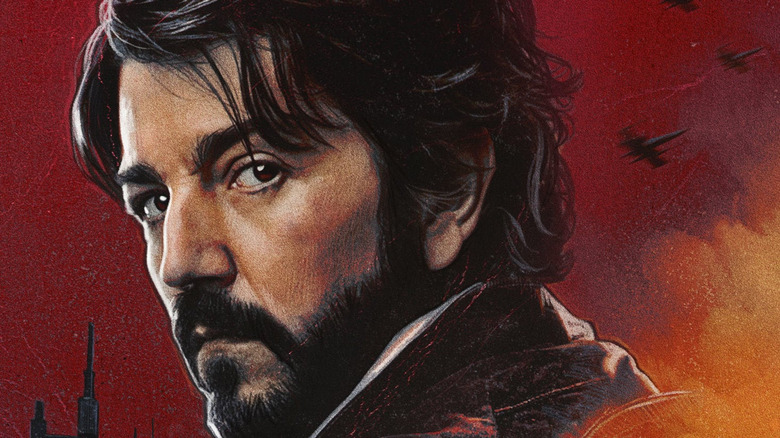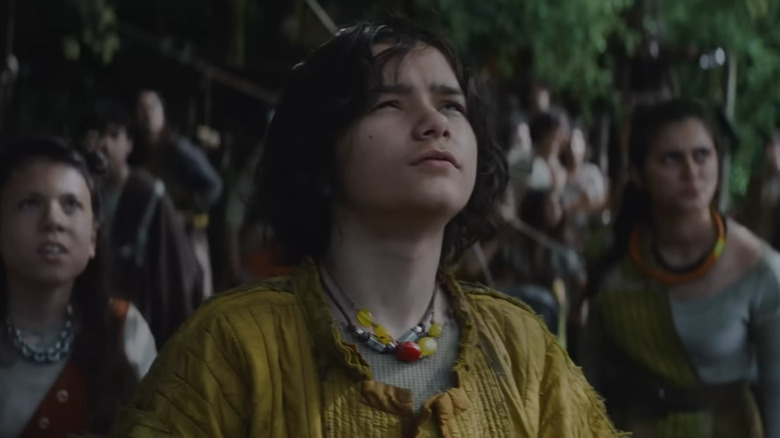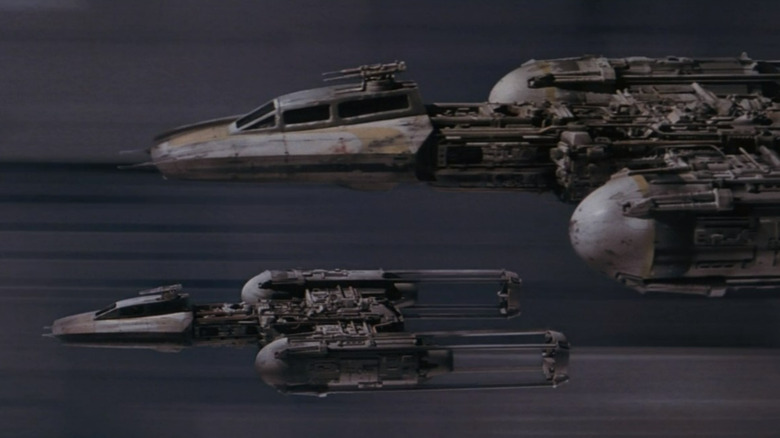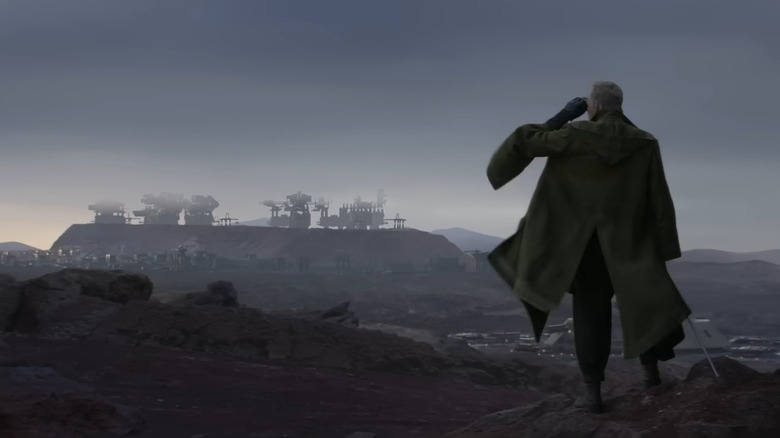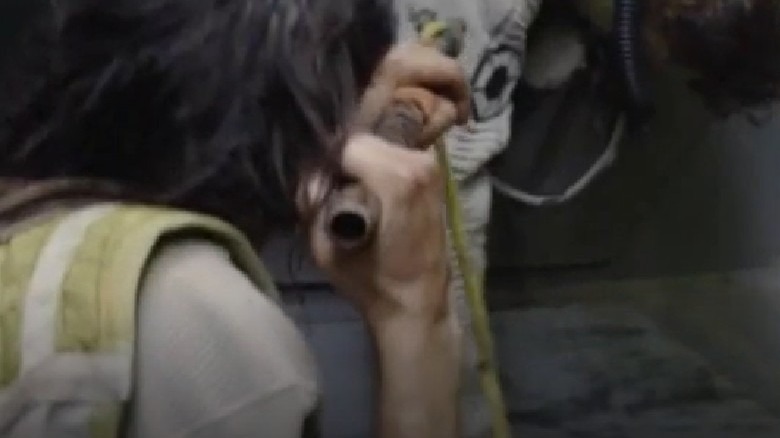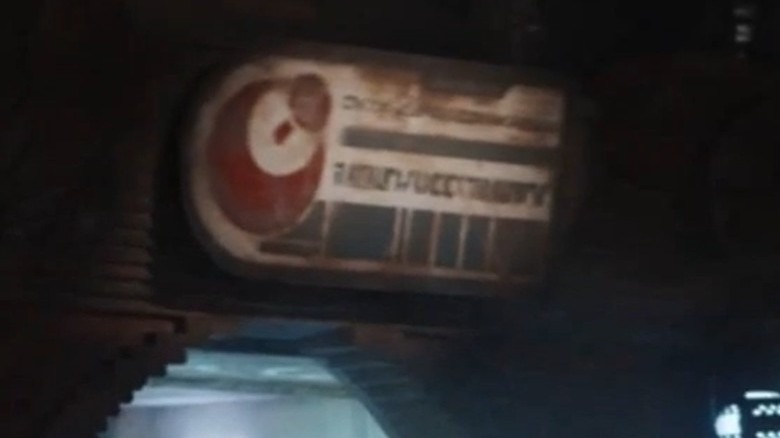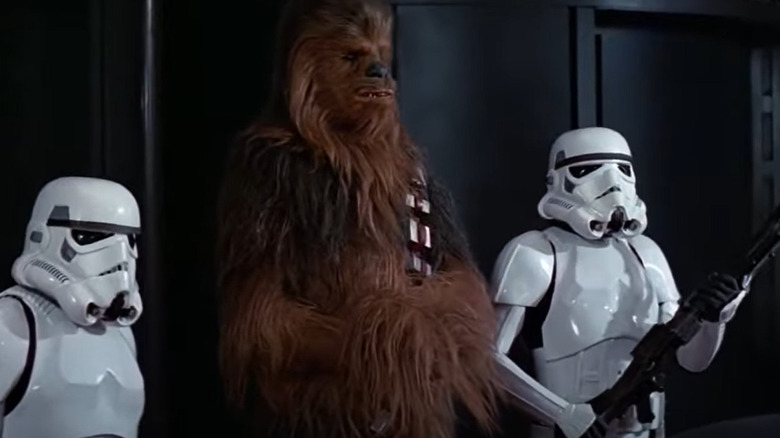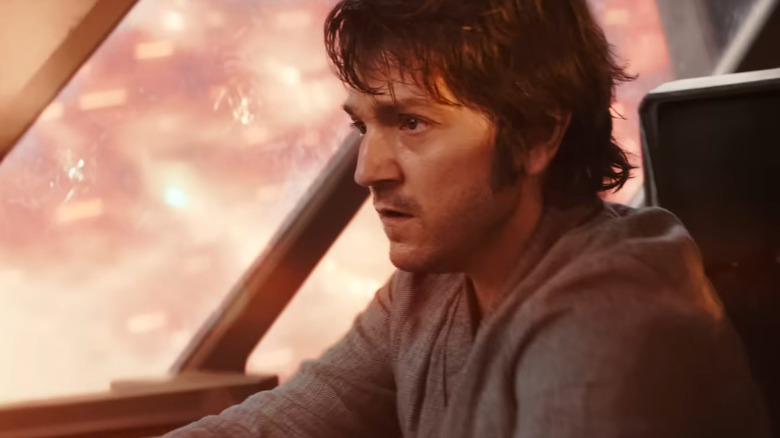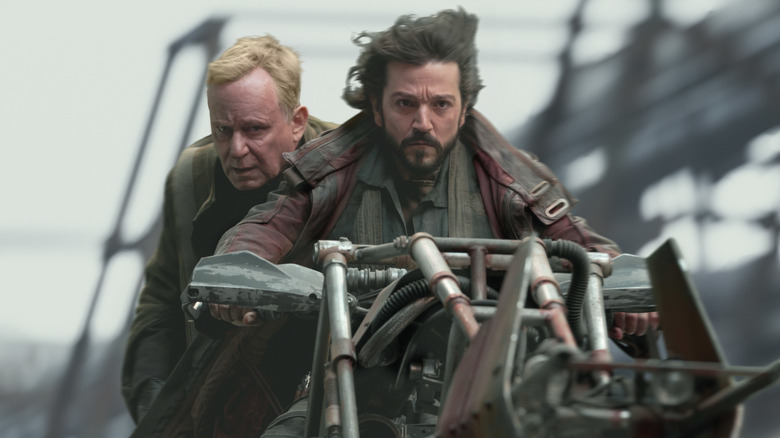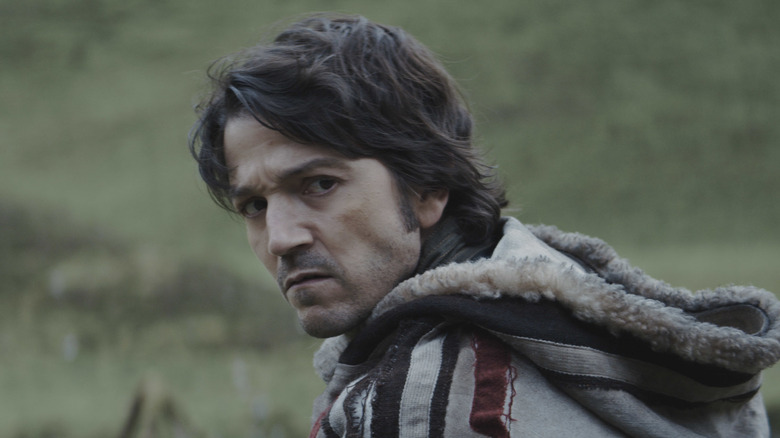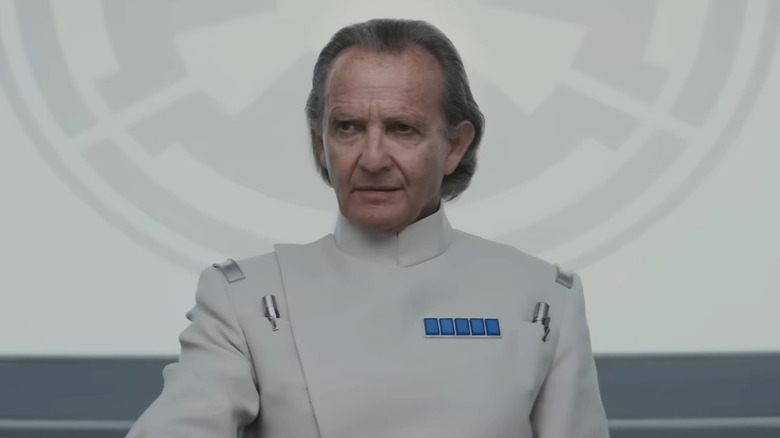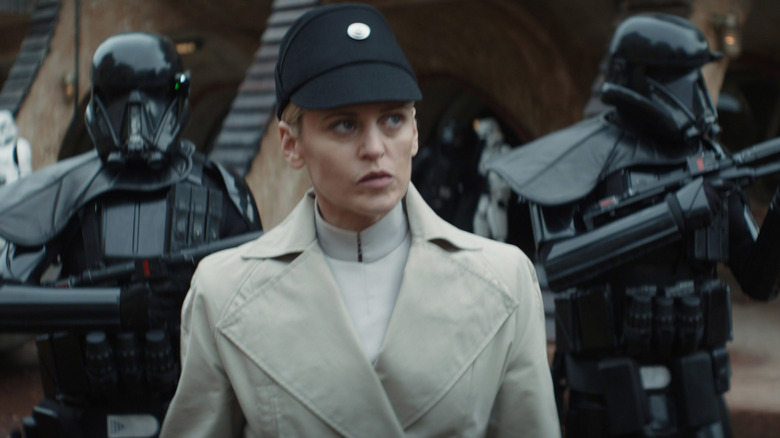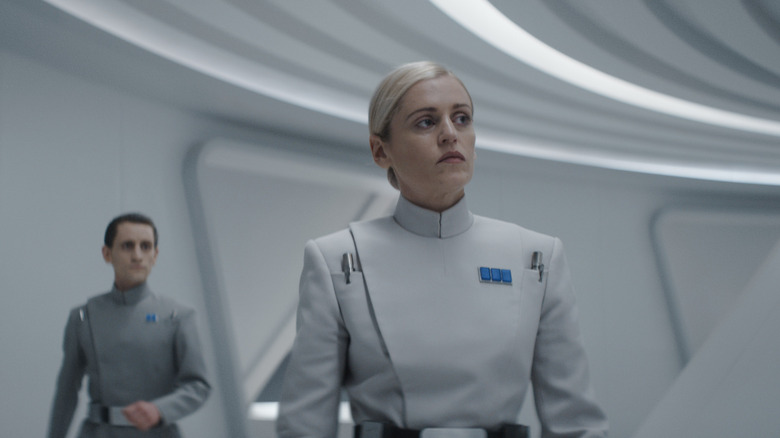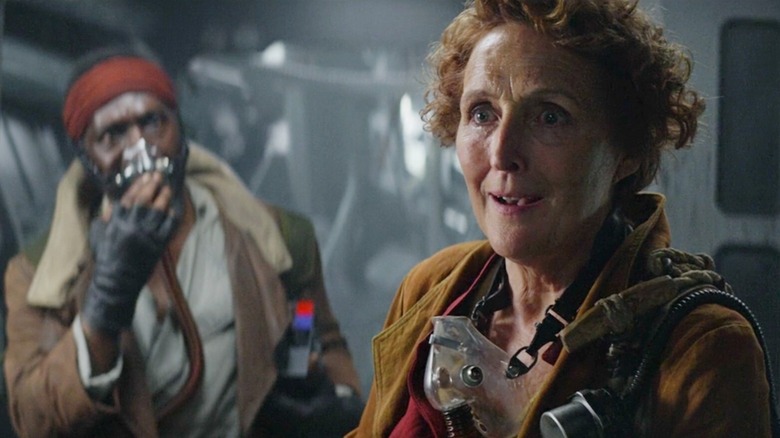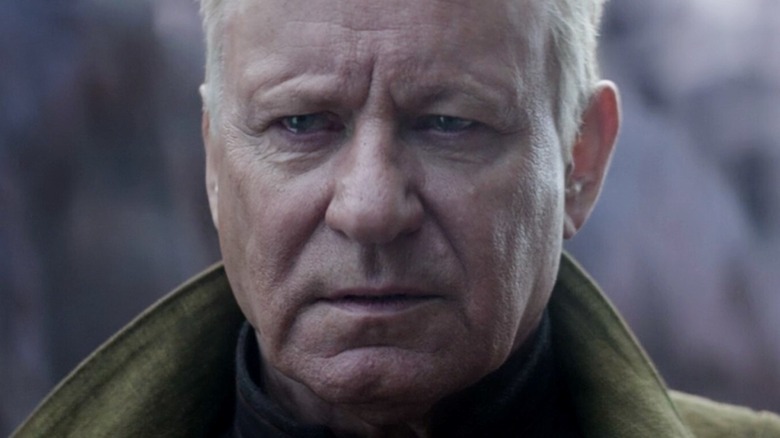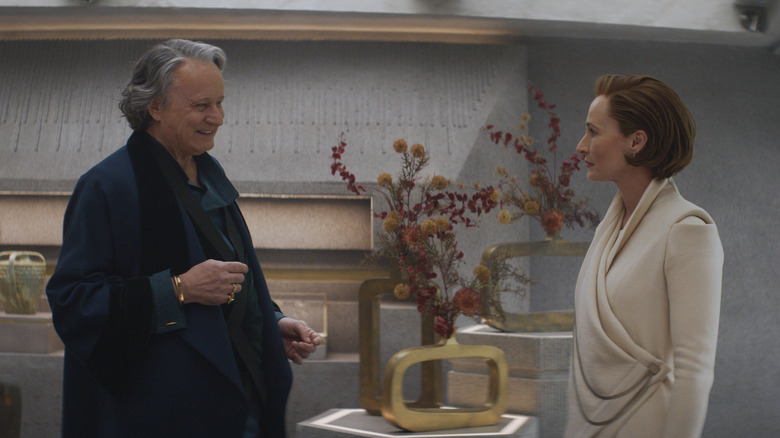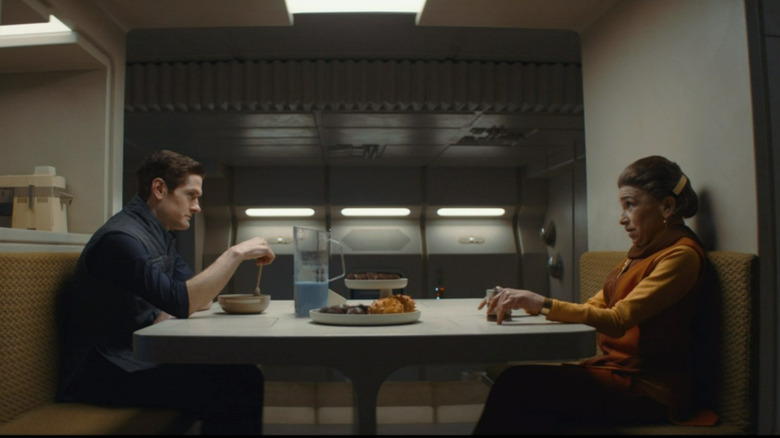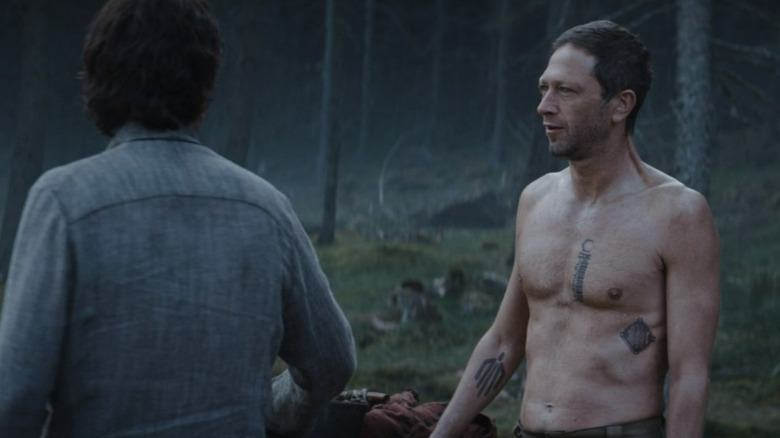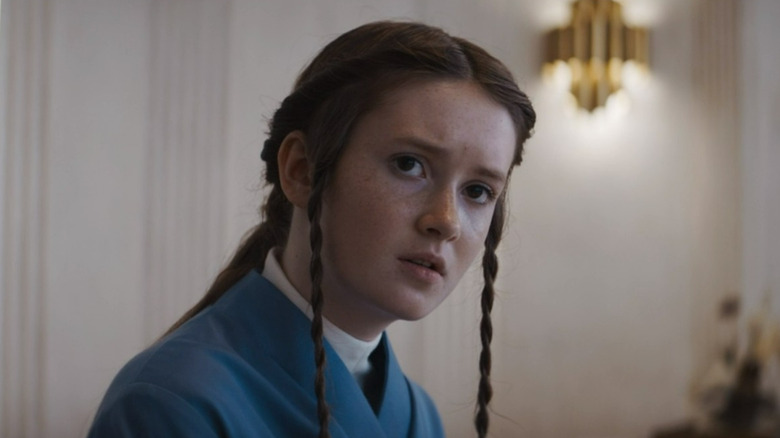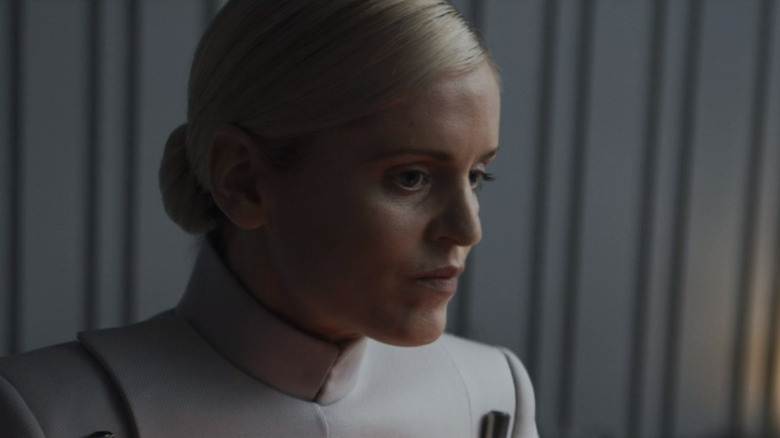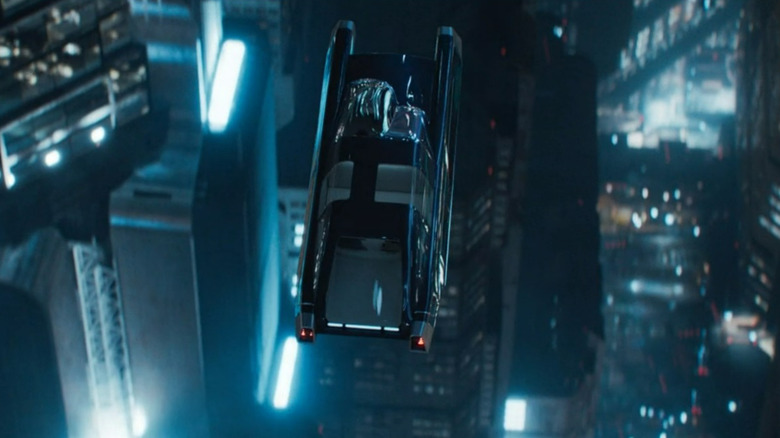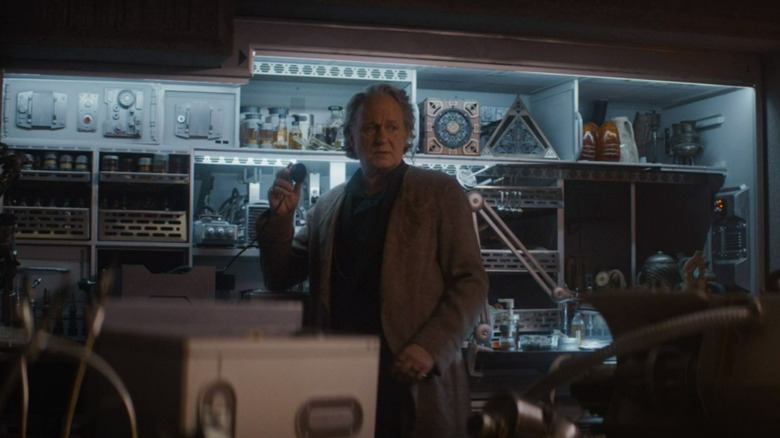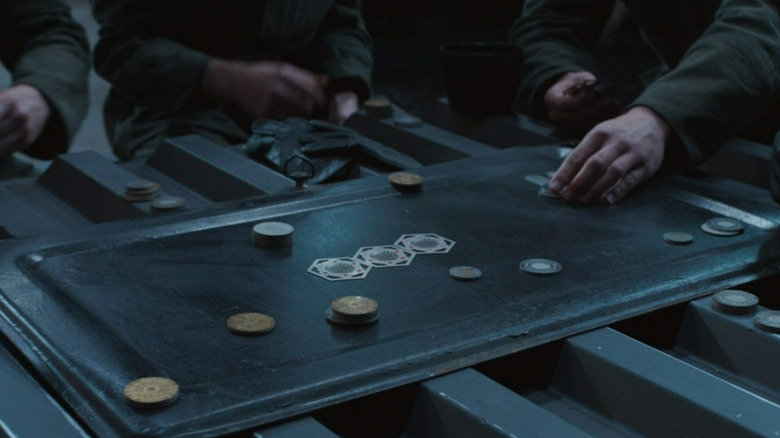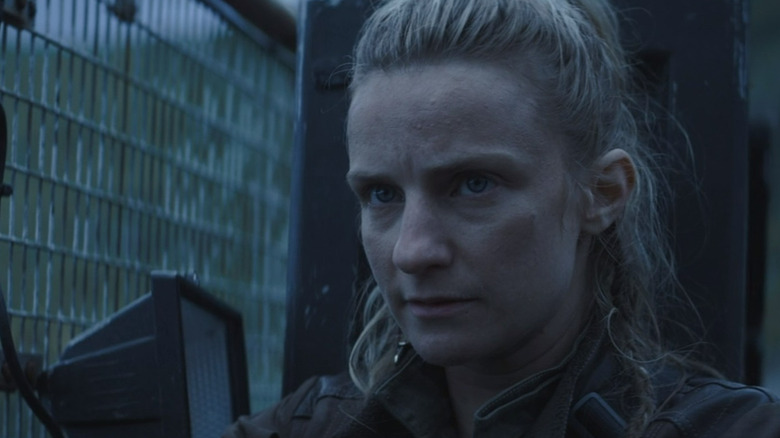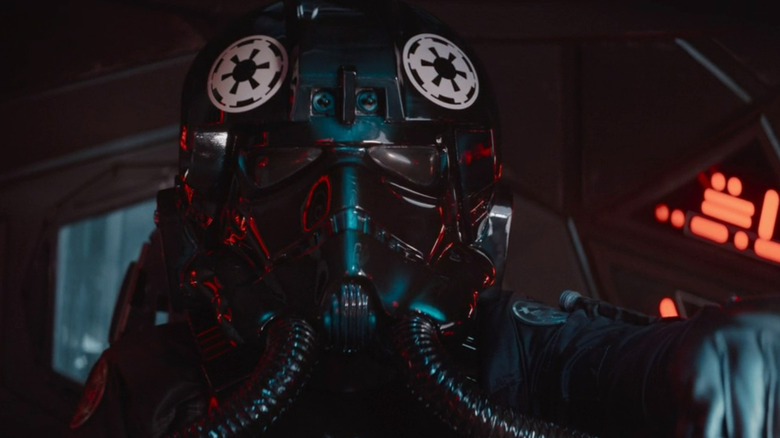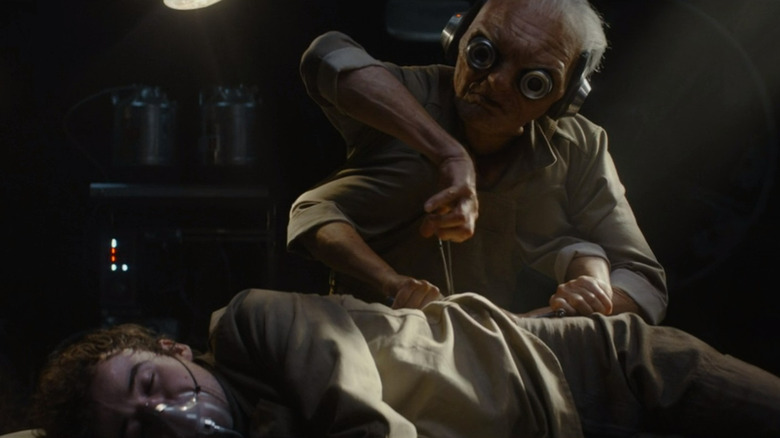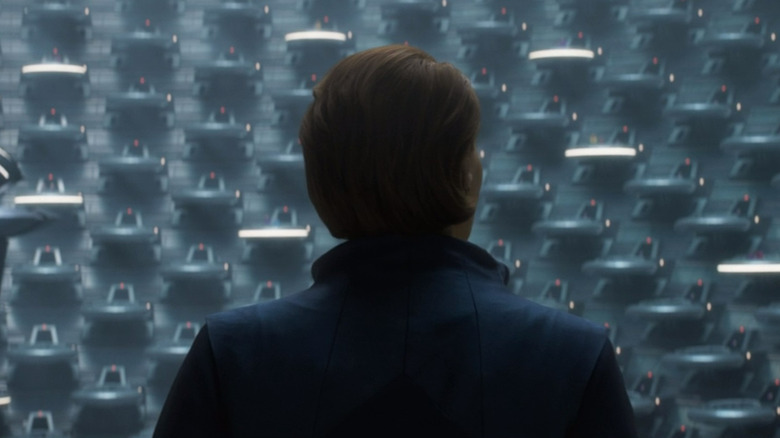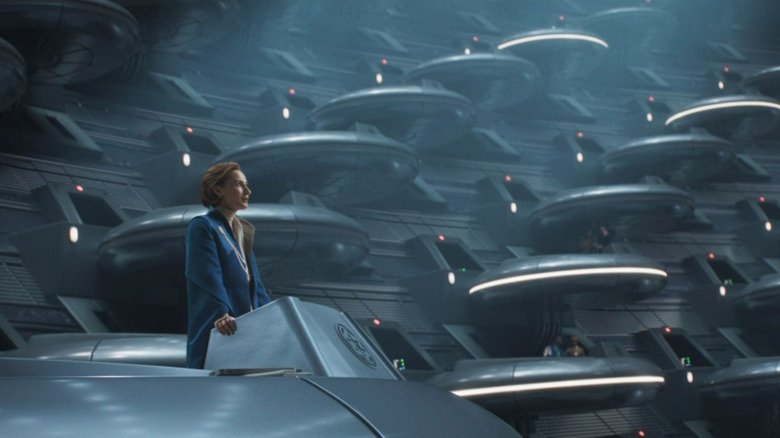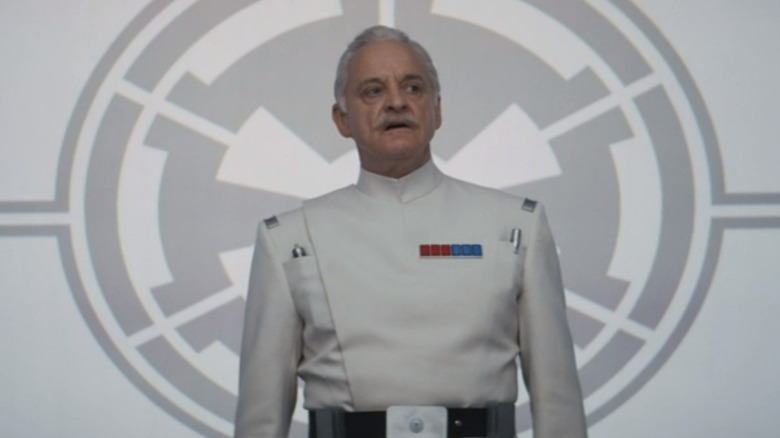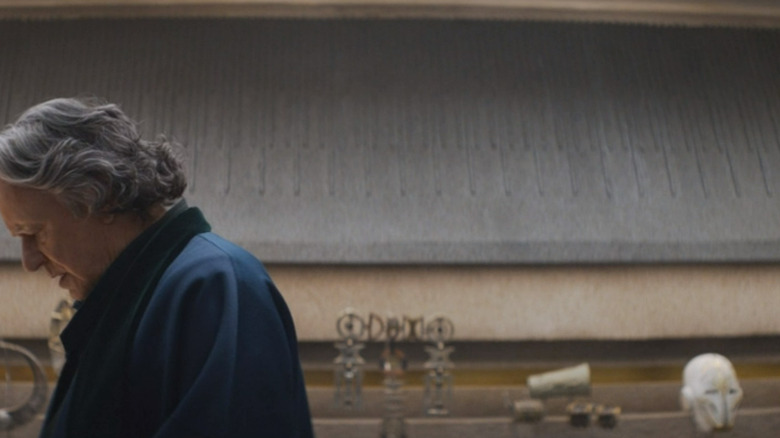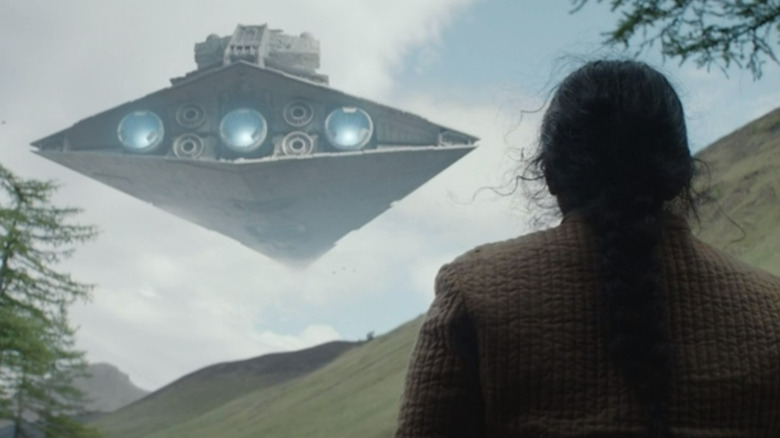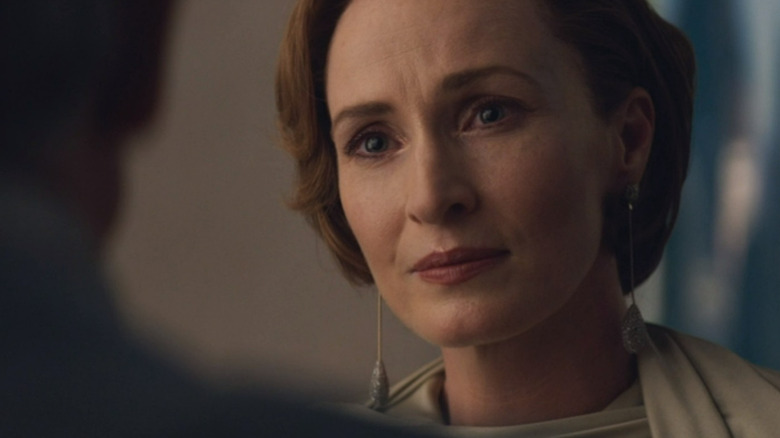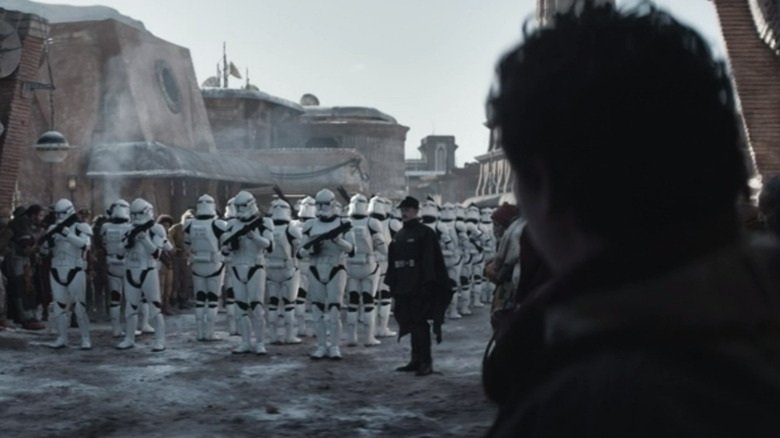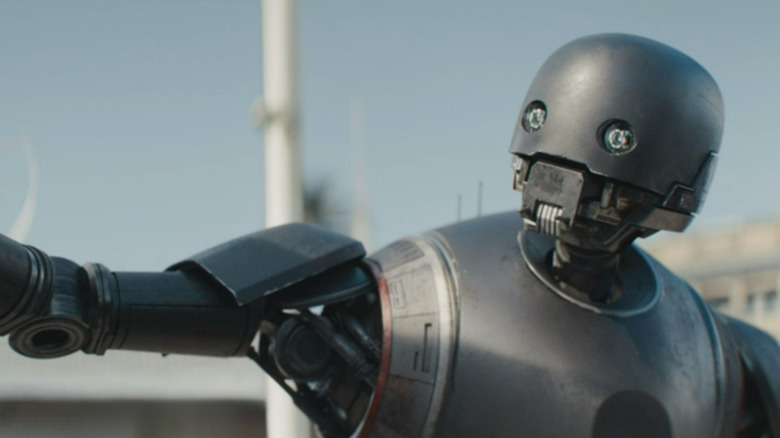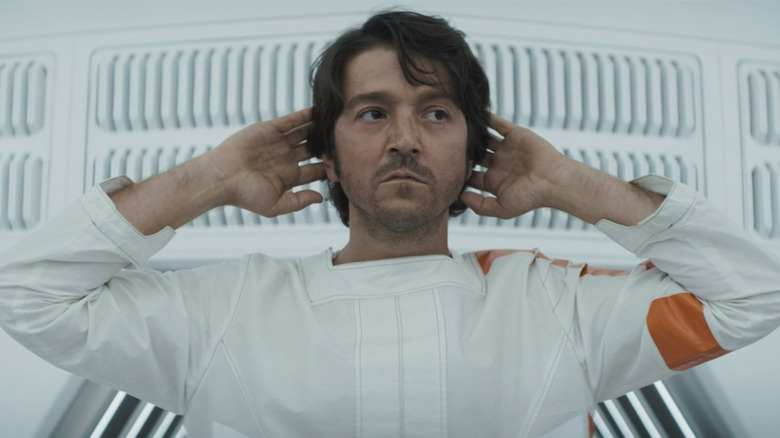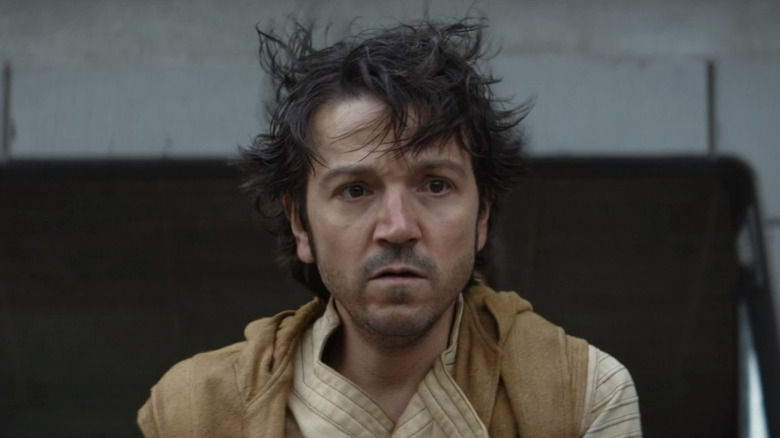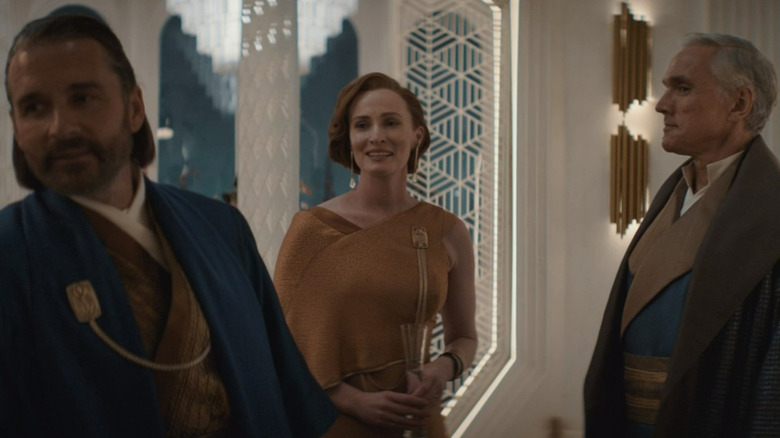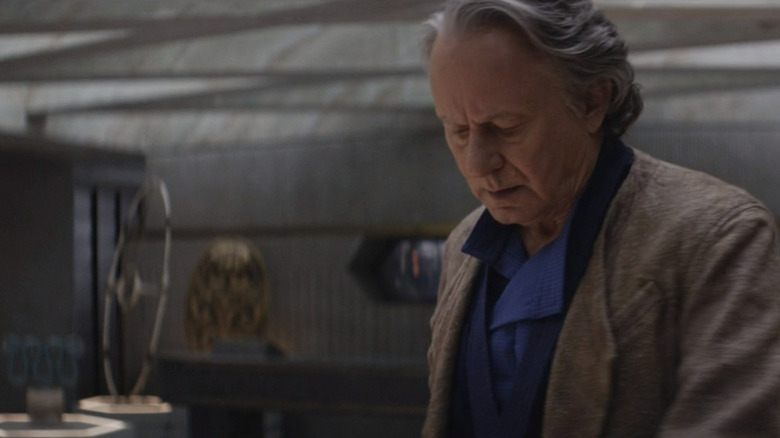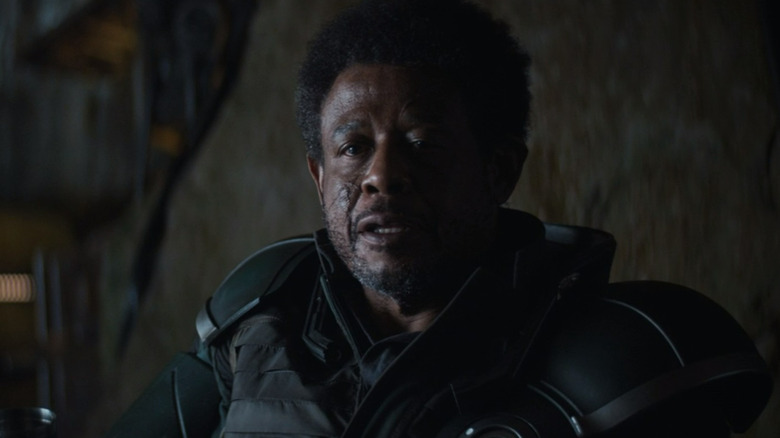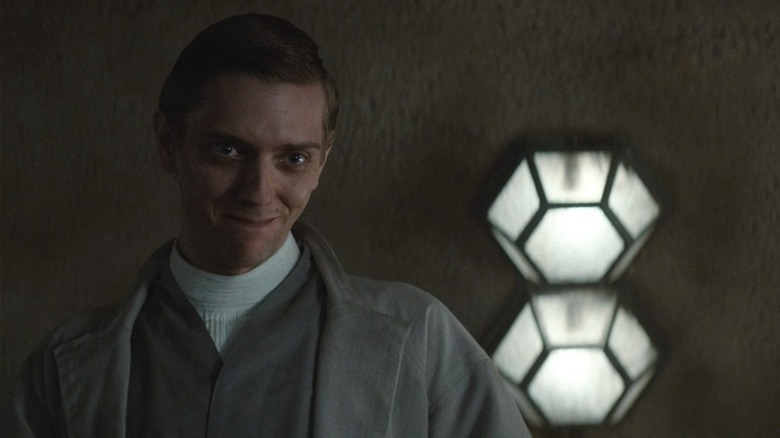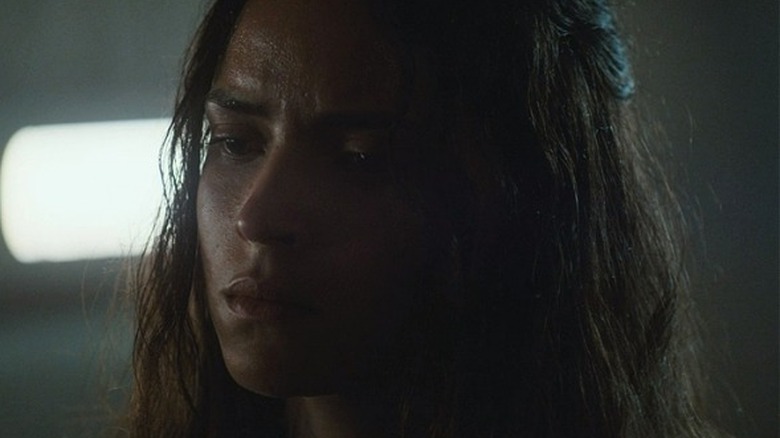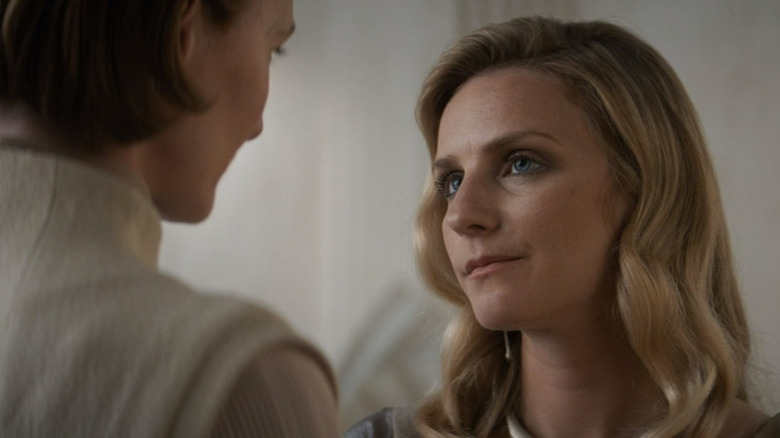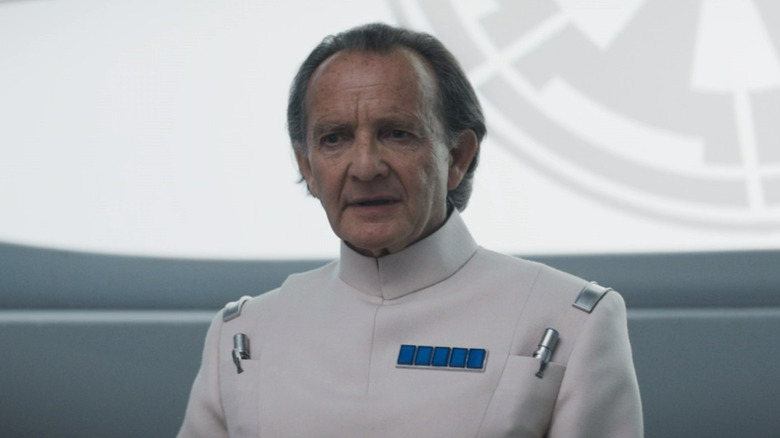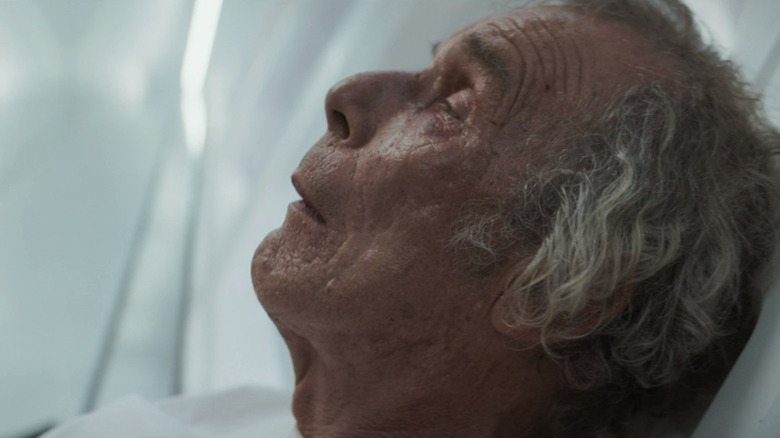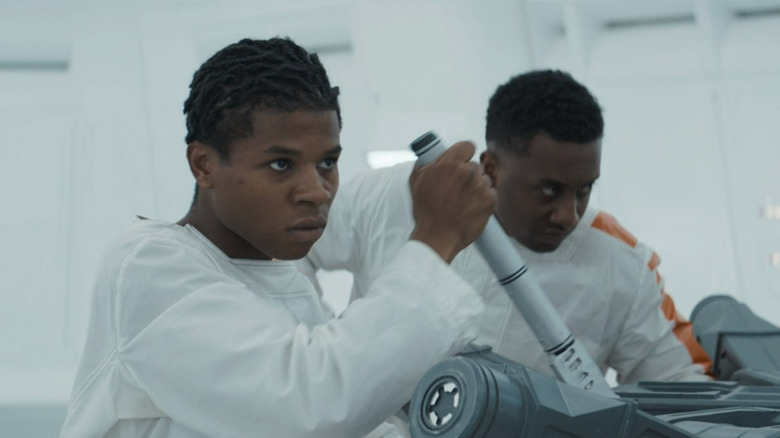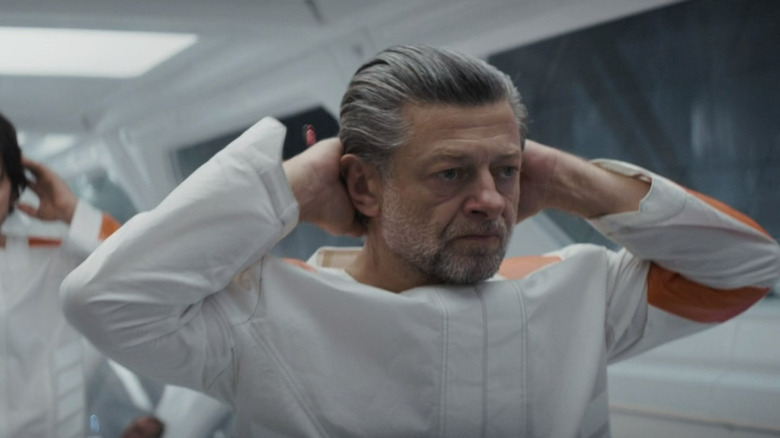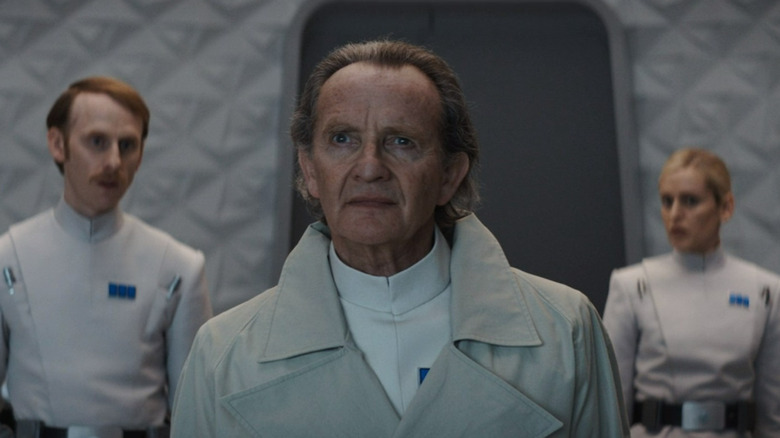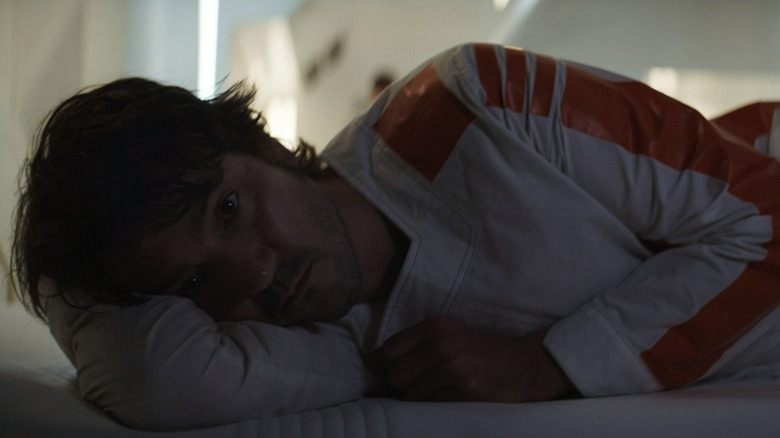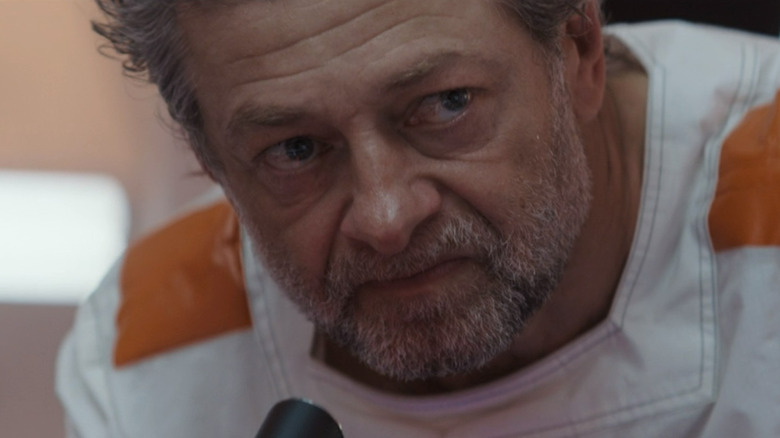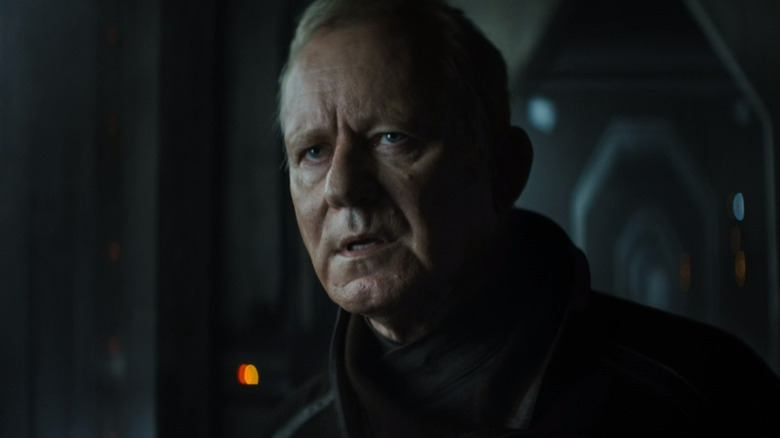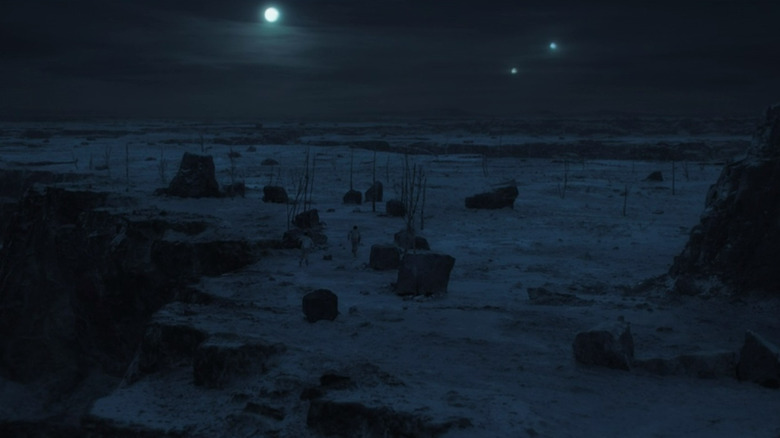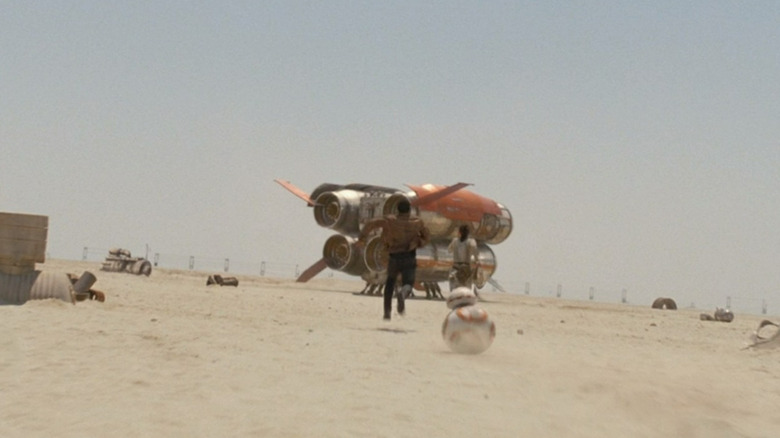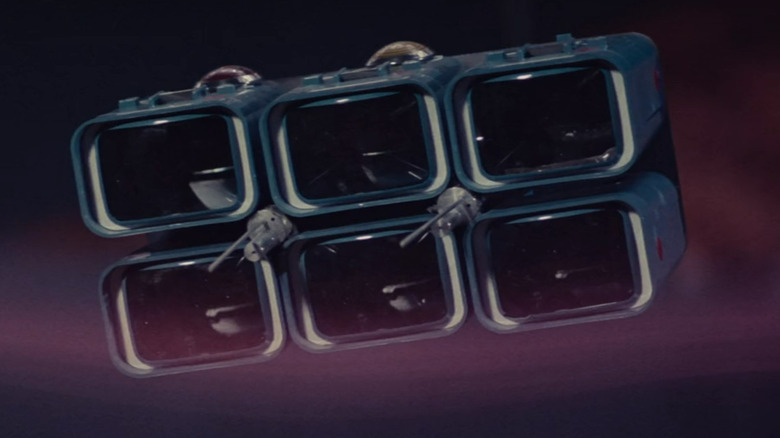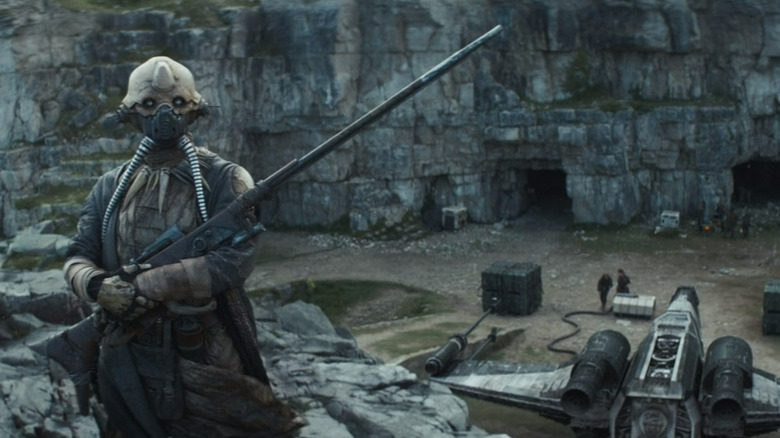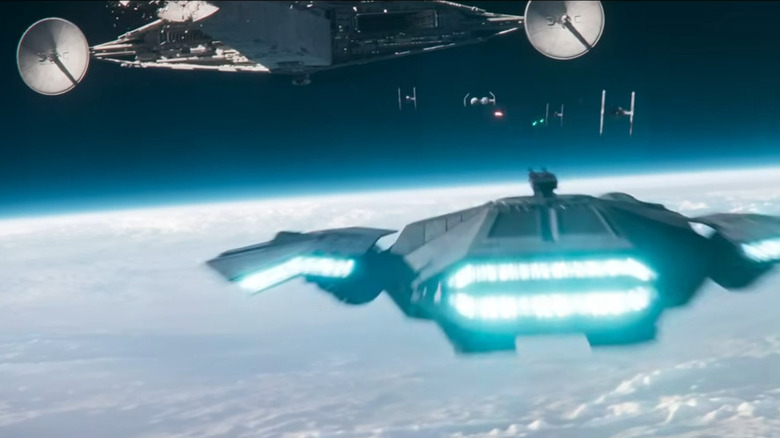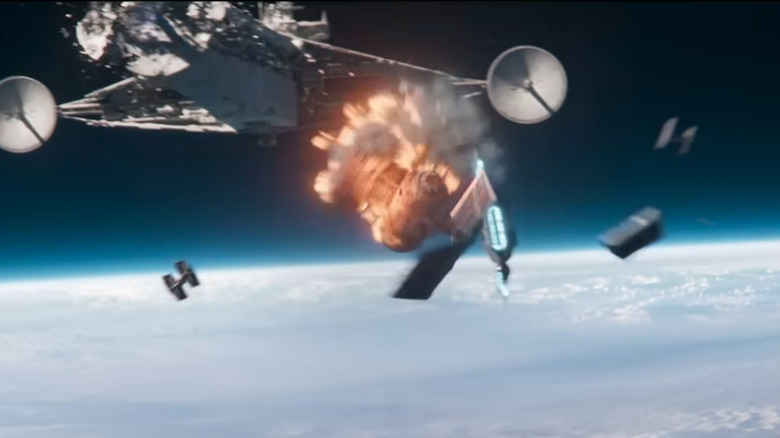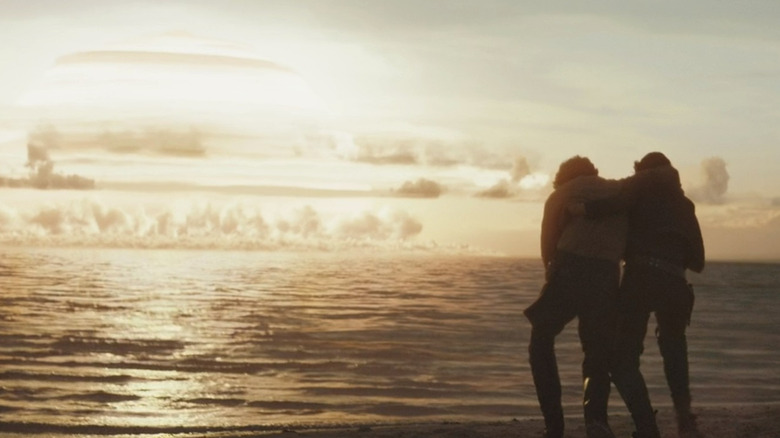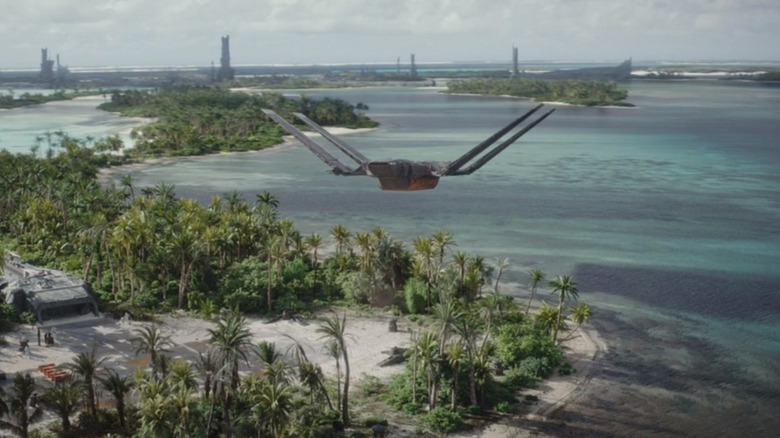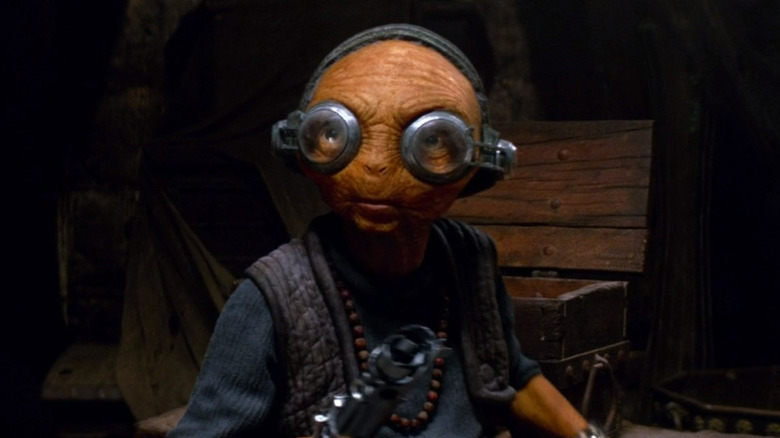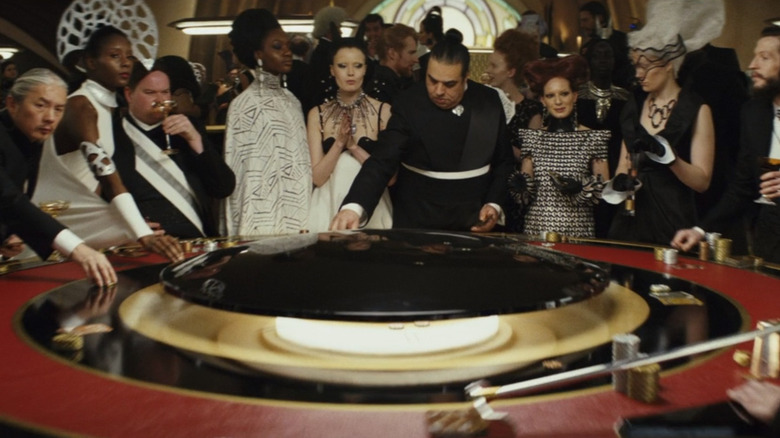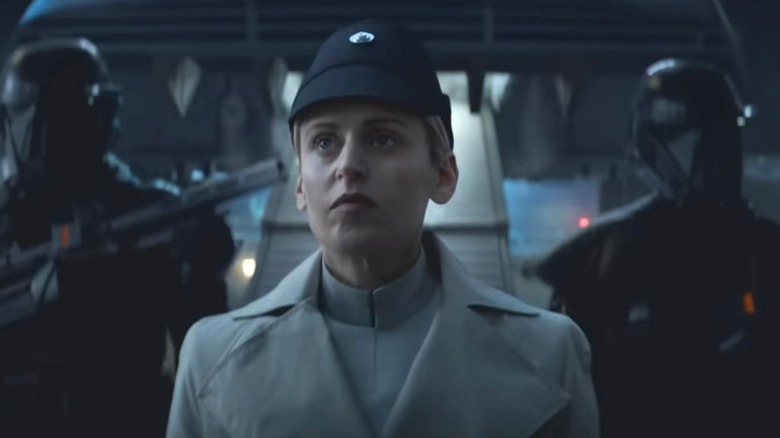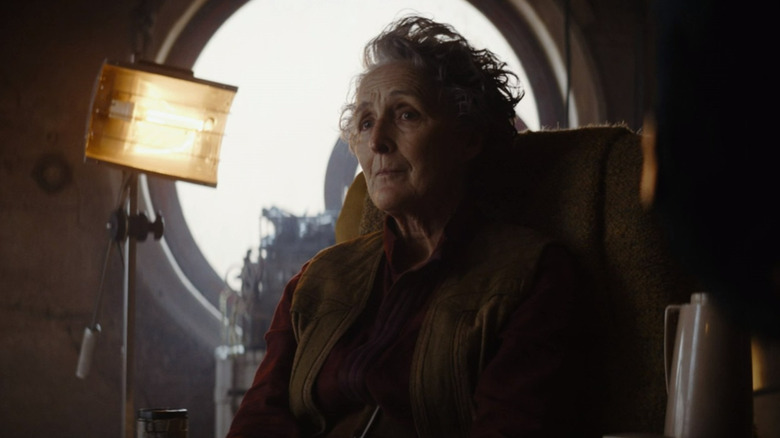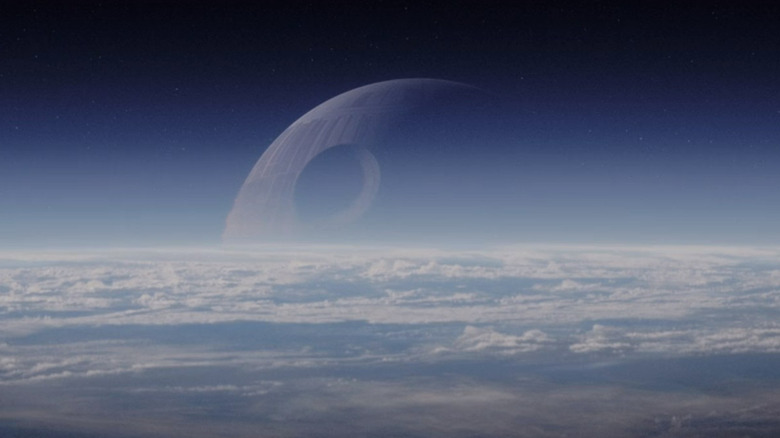Easter Eggs You Missed In Andor Season 1
Spoilers for "Andor" Season 1 ahead.
In the broad landscape of Disney's "Star Wars" streaming shows, "Andor" is something of an anomaly. It's part of the growing "Mandalorian" franchise, which includes spinoffs like "The Book of Boba Fett," but it also isn't terribly connected to the original films in the way that "Obi-Wan Kenobi" is. The only major returning character is the titular hero himself — Cassian Andor, played by Diego Luna. As such, the series has a unique opportunity to add to franchise lore, and it does just that by introducing new aspects of the Empire, new planets and systems, and a whole host of brand new characters.
Of course, this is still "Star Wars," so it's impossible to fully avoid referencing the past. While the series isn't nearly as loaded with references and Easter eggs as some of its recent sister shows, "Andor" Season 1 still has plenty of fun hidden details for eagle-eyed viewers to watch out for. With scenes set during the Clone Wars and the Imperial era, the series covers a large period of history in the "Star Wars" universe. And, as you might expect, that leads to a number of wink-and-nod moments. Here are some Easter eggs and small details that you may have missed in "Andor" Season 1.
Since I was six years old
In the very first episode of "Andor," viewers start seeing flashbacks to Cassian's childhood on Kenari, his home planet. The clips show him donning combat gear and weapons to investigate a crashed ship with the other inhabitants of his village, a mission that ultimately proves life-changing — and not necessarily in the best way. It's interesting to see such a young version of Cassian running around with a spear in hand, but if you've seen "Rogue One," you may have been expecting it.
In the movie, Cassian tells Jyn Erso (Felicity Jones) about his long history as a freedom fighter. "I've been in this fight since I was six years old," he says, emphasizing just how much of his life has been spent either on the run or in direct conflict with the establishment. While the ship he's shown investigating isn't Imperial (the Empire didn't exist at the time), "Andor" does make good on Cassian's claim of being a part of the good fight from a very young age.
Rebel ships
Though the "Star Wars" franchise has featured a ton of different starships over the decades, some have been iconic enough to stand out anywhere — even in a random shipyard on, say, Ferrix. Near the end of "Andor" Season 1's opening episode, Cassian is shown rummaging around in an old junker that he borrowed from one of the yard's employees. He plays it cool, but he's really scrubbing incriminating info from the ship's records.
During a couple of pulled-out shots, viewers may recognize a few of the other ships occupying the yard. One is unmistakably a Y-Wing starfighter, a bomber variant commonly used by the Rebel Alliance and first seen on film during the run on the original Death Star. The faded yellow cockpit of the ship can be seen clearly, complete with the iconic rotating turret. Y-Wings were first used by the Republic during the Clone Wars, so it makes sense to see a stray one junking it up on a planet like Ferrix.
The scene also shows what looks like a variant of the T-47 airspeeder from "The Empire Strikes Back." Originally manufactured as stunt fighters, T-47s were modified for various purposes by rebels throughout the Galactic Civil War. They became known as snowspeeders among the rebels. The ship seen opposite the Y-Wing in the "Andor" shipyard definitely isn't a snowspeeder (it's much longer in the back than a normal T-47), but the cockpit and wing design are quite evocative.
Classic Star Wars tech
One of the most distinct aspects of the "Star Wars" universe is its retro sci-fi tech aesthetic. When the first film was released in 1977, it made sense for the computer screens to use vector graphics and the binoculars to be full of static. As the franchise has continued and real-world technology has evolved, "Star Wars" has played with different variants on its original in-universe technology, like how the prequels employed more holographic screens instead of vectors.
"Andor" makes it clear from the get-go that its inspiration comes fully from the original, old-school tech of the first "Star Wars" films. From the numerous computer screens filled with hard lines to the digital readouts on Luthen Rael's (Stellan Skarsgård) binoculars, the show fully embraces the retro-futuristic look and feel of Ralph McQuarrie's original concept art. It's similar in many ways to the aesthetic of "The Mandalorian," but with an early Imperial era twist. If you keep your eyes peeled throughout "Andor" Season 1, you'll catch a lot of little gadgets and gizmos that have appeared in previous "Star Wars" stories.
The Separatist sigil
In Cassian's flashbacks to the ship crash on his home world of Kenari, we see how he came to be raised by Maarva Andor (Fiona Shaw) and taken far away into the galaxy. It all centers around the shipwreck itself, which Cassian investigates with a crew from his village. Things go sour when some of the passengers turn out to be both alive and hostile, leading to a violent confrontation. Who are these interlopers, and where were they headed? It's not entirely clear, but the familiar logo on their uniforms gives some indication.
On the sleeves of their spacesuits, you can clearly make out the segmented blue and white hexagon that was the symbol of the Separatist Alliance during the Clone Wars. There are no battle droids to be seen aboard the ship — the signature soldier of the Confederacy — but diehard fans will know that plenty of non-robotic beings gave their lives to the Separatist cause as well. This also might explain why the wounded crewman immediately gets violent after waking up. The ship may have been coming directly from a warzone, though of course, that's no justification for his actions.
A hidden Rebel Alliance logo?
The Separatist sigil isn't the only familiar "Star Wars" logo to make a sneaky appearance in the early episodes of "Andor" Season 1. Early on in Episode 2, a shopkeeper makes a bold (and ultimately fatal) choice — calling the cops on Cassian because he's jealous of his relationship with his partner, the mechanic Bix Caleen (Adria Arjona). To keep things anonymous, he goes to what appears to be a public transmission station of some kind. The marquee over the establishment has a red crescent logo that looks strikingly like the symbol of the Rebel Alliance.
There's almost certainly no actual connection, but the sign could be meant as a subtle allusion to the fate that soon comes for Cassian Andor. The call placed from the transmission center is the indirect cause of him following Luthen into the rebel cause, and the similarities between the two logos seem too obvious for this to be a pure coincidence.
Clone Wars surplus
When the corporate security agents come to Ferrix to hunt Cassian in "Andor" Episode 2, they come prepared. Not only do they gear up with some major firepower, but they drop down to the planet's surface in ships that are strikingly reminiscent of the Republic gunships used in the Clone Wars. The iconic design was first seen in "Attack of the Clones," and it has remained a staple of "Star Wars" ever since. While there are certainly differences between the old gunships and the landing craft seen in "Andor," their striking similarities are interesting to say the least.
In the wake of the Clone Wars, the Empire phases out a lot of the gear used by the clone army. Old starfighters become TIE Fighters, AT-TEs become AT-ATs, and the old clone gunships are nowhere to be found. It would make sense for a private military company like the one seen in "Andor" to purchase some of this surplus tech for its own purposes, perhaps even making some modifications along the way. That could explain the ship design in Episode 2 — or maybe the same manufacturer simply built some new models after the war.
The Empire's terrible security
During their first meeting in "Andor" Episode 3, Luthen Rael asks how Cassian managed to steal the "untraceable" Imperial tech he's bartering off. "You just walk in like you belong," he says. "To steal from the Empire, what do you need? A uniform, some dirty hands, and an Imperial toolkit." This line could be taken as a nod to the many, many times rebels have successfully infiltrated Imperial strongholds using basic disguises throughout the franchise — a long and storied trope worthy of the reference.
Whether it's Han and Luke disguising themselves as Stormtroopers on the Death Star or Obi-Wan Kenobi being snuck into the Imperial Inquisitor's citadel by a double-agent, many characters have walked right past the Empire's defenses with little more than courage and a cool hat. Cassian himself uses this exact tactic at the end of "Rogue One," when he and Jyn Erso break into the Imperial base on Scarif to steal the Death Star plans. As such, his line about "borrowing" uniforms can also be taken as a grim foreshadowing of his own eventual demise.
Cassian Andor's narrow escapes
At the end of "Andor" Episode 3, we're treated to a beautifully shot sequence that parallels Cassian's departure from Kenari as a young boy with his escape from Ferrix with Luthen Rael. It's a powerful and haunting moment, showing the character's talent for making it out by the skin of his teeth. The scene is tragic — not only because it emphasizes how Cassian must repeatedly leave things behind, but because it foreshadows the one time he finally doesn't make it out.
Most people who watch "Andor" will already know Cassian's ultimate fate — that he dies at the end of "Rogue One" after giving the Rebellion the tools it needs to defeat the Empire. It's particularly affecting, then, to see that earlier in his life, Cassian was known for narrow getaways. So many different times in his life, he almost dies — or almost gets caught — only to narrowly escape. Clearly, his wits take him quite far in his struggle against totalitarianism, but even Cassian Andor's luck must eventually run out.
The many faces of the rebellion
After leaving Ferrix with Luthen Rael, Cassian Andor is given a choice — get dropped off on the closest planet and start running or come with Luthen and fight against the Empire. At first, Cassian is resistant to the idea of joining the Resistance. When asked by Luthen who he thinks he is, Cassian lists off several different Rebel sects and says that they're all the same to him — groups that he wants no part of. Of course, those different Rebel sects should sound familiar to long-time fans.
Cassian mentions the Alliance first, shorthand for the Alliance to Restore the Republic, which becomes the dominant Rebel force during the events of the original trilogy. He also names "guerrillas" and the "Partisan Front" — both names associated with the Rebel leader Saw Gerrera, who's once again played by Forest Whitaker in "Andor." It makes sense that Cassian would think of these groups as separate organizations, as it took some time for the rebellion to become truly unified. Additionally, Saw is always held at arm's length by the Alliance due to his willingness to go to violent extremes, leading some to label him a terrorist.
Lastly, but most interestingly, Cassian names "Sep" in his list of Rebel groups. Presumably, this is a reference to the Separatists — the Republic's enemy during the Clone Wars. Some Separatist holdouts did indeed align with the Rebellion during the Imperial era, as shown in "Star Wars Rebels."
Mimban
During his conversation with Luthen in "Andor" Episode 4, Cassian describes his time as a conscripted soldier in the Imperial military. He says that when he was 16 — just after being released from prison — he was sent to fight on a planet called Mimban. Luthen calls out several lies in his story, but acknowledges that Cassian did spend some time on the mud-soaked planet before running away.
If you've seen "Solo: A Star Wars Story," you'll likely remember Mimban. It's the same drab world that the young Han is shown fighting on early in the film. In the greater "Star Wars" canon, Mimban has long been valued for its rich natural resources. As a result, it's been fought over many times by different factions, including during the Clone Wars. While Cassian may not have spent as long on the muddy planet as he initially claims, it's safe to assume that his tenure there was still horrific. If Han Solo's own experiences on Mimban are any indication, there's very little joy to be found when serving the Empire there.
The Imperial Security Bureau
Much of "Andor" Episode 4 is spent at the Imperial Security Bureau on Coruscant, a military intelligence agency dedicated to preventing uprisings and turmoil. While the aesthetics of the ISB are a bit different than anything previously seen in a live-action "Star Wars" project, this is far from the first time that the organization has appeared in canon.
The Imperial Security Bureau plays a major role in the animated series "Star Wars Rebels," presenting one of the major antagonistic forces that works against Ezra Bridger and his allies. The ISB also pops up in many of the Disney era's more extraneous stories, like the "Thrawn" and "Darth Vader" comic books.
In "The Mandalorian," it's even revealed that ISB remains operational through the Imperial remnants scattered across the galaxy. For instance, the military installation on Morak infiltrated by Din Djarin and Migs Mayfeld in Season 2 is primarily operated by former members of the ISB. This just goes to show how powerful the agency was and how many aspects of Imperial rule it was wired into during its heyday.
Rebels in the Ryloth sector
The first "Andor" scene set at the Imperial Security Bureau shows a meeting among senior staff discussing rebel status across the galaxy. At the start of the scene, one officer is heard describing circumstances in the Ryloth sector, warning that extra funds may be needed in the near future to properly combat ant-Imperial activity. Diehard "Star Wars" fans will surely know Ryloth, as well as its penchant for rebellion.
Ryloth has a long and dark history of oppression, stretching back to before the days of the Clone Wars. Once the Empire rose to power, the system was subjugated even further, but its citizens' familiarity with tyrannical regimes made it difficult to control entirely. "Star Wars Rebels" details the actions of the Free Ryloth Movement, a resistance effort led by the charismatic Cham Syndulla and supported at different times by larger sects of the Alliance to Restore the Republic. Given the time period in which "Andor" is set, it makes sense that Ryloth would be a particularly fickle region for its Imperial rulers to deal with. Mentioning the planet's predilection for rebellion is a nice touch and a great way to show the nature of the ISB right out of the gate.
Sending supplies to Scarif
Another matter briefly mentioned during the first Imperial Security Bureau scene in "Andor" is the increase in supply shipments to Scarif. Of course, that's where research, development, and construction on the Death Star is taking place. Ending the ISB scene with this subtly dark line sets the tone for the Empire's activity at this point in the "Star Wars" timeline, but it's also strikingly relevant to Cassian's personal story.
Scarif is the place where Cassian Andor dies. It's the end of his long fight against oppression in the galaxy. The Battle of Scarif will likely hang over his head for the entirety of the show, as anyone watching will be intimately familiar with what befalls him there. Because of that dramatic irony, "Andor" functions in part as a tragic saga. But of course, Cassian has a long way to go before he gets to Scarif personally, and he makes some big plays against the Empire along the way.
Cassian's new name
When Cassian gets dropped off by Luthen to join other rebels in "Andor" Episode 4, he's told to pick a new name. It's a smart move given all the commotion he causes on Ferrix, and it's surely not his first or last occasion working under an alias. After a brief moment of consideration, Cassian says that his new name will be Clem. If you weren't paying close attention to the earlier episodes, the significance of this choice might fly right by you.
A good deal of time is spent on Cassian's adoptive mother Maarva (Fiona Shaw) in the early episodes of "Andor," but he also had an adoptive father who's shown with Maarva in flashbacks. That character, played by Gary Beadle, is named Clem. In another conversation between Luthen and Cassian, it's also revealed that Clem was executed by Imperial agents when Cassian was still young. With all that in mind, his choice of alias is particularly significant. Not only is he paying tribute to his late father, but he's doing so while fighting against the regime that killed him.
The kyber necklace
Before leaving Cassian to return to Coruscant, Luthen gives him a gift — a "down payment." The item is a blue kyber crystal necklace, which has multiple layers of significance. On the most basic level, the necklace represents an attunement to the Force, which has always been shown to be a rallying call for the Rebel Alliance. Also of note is that Jyn Erso (Felicity Jones) has a similar kyber necklace in "Rogue One." Given that she and Cassian share their final days together, it's poignant that he also gets one. And of course, kyber is a huge plot device in the greater story of "Rogue One," as it's the power source behind the Death Star's superlaser. This makes Luthen's gift somewhat grim, as it foreshadows the way Cassian will ultimately meet his end.
Beyond all that, though, Luthen's gift holds extra significance for those well versed in the more extraneous corners of the old "Star Wars" canon. Luthen calls the necklace a "Kuati signet," referencing the planet of Kuat, which was hugely important in the formation of the Republic in the now defunct "Star Wars Legends" timeline. To make things even more interesting, Luthen says that the signet "celebrates the uprising against the Rakatan invaders." That's a deep, deep cut into the franchise's far-flung past. During the era before the Jedi and the Sith, much of the galaxy was conquered by the villainous Rakatans in the "Legends" lore. Now, it seems that's canon once again.
Luthen's shop of secrets
When he's not roaming the galaxy recruiting freedom fighters, Luthen Rael runs a gallery of historical items on Coruscant. He uses the business as a front for communicating with other rebel figures such as Mon Mothma. However, the shop's merchandise is also quite legit, and eagle-eyed "Star Wars" fans may notice a couple items of interest on the various display racks.
The most obvious object of note is what appears to be a Mandalorian breastplate. The piece is in good condition and of unknown age, but it bears the distinct etchings and designs that fans will know from the likes of Jango Fett and Din Djarin. Behind that piece, there's a full set of less familiar armor complete with a distinctive helmet. At first, it looks reminiscent of the outfits worn by the Knights of Ren, but a closer look suggests a more obscure Easter egg. The helmet in particular seems almost identical to the one worn by Starkiller in the no-longer-canon "Star Wars: The Force Unleashed" video games. That helmet is part of a set known as Sith stalker armor, which pulls from ancient Sith designs.
Unfortunately, we don't get a good enough look at Luthen's armor to tell exactly what it is. Given that the Knights of Ren exist in some form long before the events of "Andor," and that they adhered to the principles of the dark side, the armor could be a reference to them and the Sith.
Blue milk
What do you do after your attempt to capture Cassian Andor gets you fired from your corporate security gig? If you're Syril Karn (Kyle Soller), you go back to your mom's house to figure things out. Syril's mother Eedy (Kathryn Hunter) isn't exactly the most compassionate woman in the galaxy, however, and she starts berating her son for his mistakes almost as soon as he shows up on her doorstep. But what she lacks in emotional openness, she at least tries to make up for by providing her son with a balanced breakfast.
Blink and you'll miss it, but while staying at his mom's place, Syril is seen eating a daily bowl of cereal — some kind of intergalactic Fruity Pebbles, perhaps — doused in blue milk. The famous drink first appears in the original "Star Wars," where it's a staple of Luke Skywalker's diet on Tatooine. "Andor" confirms that blue milk is common in other stray corners of the galaxy — and that it can be used, like normal milk, to juice up some cornflakes. Hopefully, it tastes better over cereal than it looks when Syril eats it.
Skeen's tattoos
One of the members of the rebel crew joined by Cassian in "Andor" Episode 4 is Arvel Skeen (Ebon Moss-Bachrach), man with a long and dark history with the Empire. At one point in Episode 5, Cassian approaches Skeen while he's going through his belongings. There's a clear distrust between the two men, but they also share a common background, as revealed when Skeen starts asking Cassian if he recognizes his tattoos.
The first mark that Skeen mentions is located on his chest. Cassian refers to it as a "Krayt head" — seemingly a reference to the Krayt dragons most commonly seen on Tatooine. The second tattoo that Skeen indicates, located on his forearm, is in the shape of a claw. "By the Hand," Cassian says when asked to identify it.
It's unclear exactly what these tattoos mean, or how Skeen came to have them, but what is clear is that Cassian knows them because of his time spent imprisoned by the Empire in his youth. "By the Hand" could be a reference to the Empire of the Hand, the subsect of Palpatine's regime ruled by Grand Admiral Thrawn. That particular Imperial division hasn't really played a role in the Disney canon before, but "Andor" seems happy to bring old Legends material back into the fold, so anything is possible. Perhaps Skeen and Cassian were both oppressed by Thrawn's governance. Perhaps the Grand Admiral himself could show up later on.
Leida Mothma
In "Andor" Episode 5 we meet Leida Mothma, the adolescent daughter of Mon Mothma and her husband Perrin. Though she gets to enjoy the luxuries of Coruscant high society, Leida seems resentful of her senator mother and her focus on work. "It's all about you, isn't it?" Leida says to her mom at one point, revealing what's clearly some deeply held anger. Unfortunately for Mon Mothma, family strife is the least of her worries.
"Andor" viewers may be surprised to learn that Leida Mothma isn't actually an entirely new character. Under the slightly different spelling of Lieda, she previously existed in the "Star Wars" Legends timeline, which was made non-canon after the Disney acquisition. Even then, Lieda is hardly mentioned, but she is named in the 2005 comic "Entrenched," in which her (yet to be re-canonized) brother Jobin sends a letter home from the Battle of Hoth.
The fact that the writers of "Andor" would dig so deep into the "Star Wars" lore to bring back Mon Mothma's original daughter, rather than just give the character a totally different name, speaks volumes. Clearly, this is a team with deep reverence for the franchise's past, both canon bits and not.
Rebel planets
One scene in "Andor" Episode 5, "The Axe Forgets," takes place at the Imperial Security Bureau on Coruscant. Officer Dedra Meero (Denise Gough) is continuing her investigation of rebel activity with her assistant, desperately tying to connect seemingly unrelated thefts and incidents across the galaxy. If you've been a fan of the "Star Wars" franchise for a while, several of the planets named in Dedra's report should sound familiar.
Kessel is probably the most commonly known planet mentioned in the scene because of the eponymous Kessel Run. As the biggest site of spice mining in the galaxy, it's a huge asset to the Empire, so it would make sense for the rebels to strike there. Dedra's assistant also mentions an incident on Fondor — a major imperial shipyard planet in the expanded "Star Wars" fiction — as well as one on Jakku, which is where Finn finds Rey in "The Force Awakens." At the beginning of the scene, the planet Hosnian Prime is also mentioned. It's a location that pops up throughout the "Star Wars" timeline, most famously as the seat of the New Republic in the sequel trilogy.
Coruscant skyways
Less of an Easter egg and more of a fun throwback, "Andor" Episode 5 shows the skyways of Coruscant in live action for the first time since "Attack of the Clones." The speeder that Mon Mothma and her husband Perrin are seen riding in is very similar to the one that Anakin Skywalker and Obi-Wan Kenobi borrow to chase the bounty hunter Zam Wessel, complete with all the shimmer and shine of the planet's upper crust.
Very little of Coruscant's Imperial era has been shown in canonical "Star Wars" stories, so it's fun to get a look at the city through the eyes of Mon Mothma. If the speeders and traffic lanes are any indication, it would seem that some things haven't changed all that much. Of course, the truth behind the scenes is much more sinister, as Mon Mothma knows quite well. Even her driver, it seems, can't be trusted.
It belongs in a museum!
Luthen Rael's strange shop of historical trinkets is home to many hidden Easter eggs, and not all of them are references to the "Star Wars" universe. In particular, the gallery features a couple subtle nods to the "Indiana Jones" movies, which also owe their existence to George Lucas. In Episode 4, Indy's whip can be seen frozen in carbonite. This is clearly a reference to how Harrison Ford, who's played Indiana Jones in every film, was also frozen in carbonite while portraying Han Solo in "The Empire Strikes Back."
In Episode 5, there's an even more obscure "Indy" Easter egg hiding in the final scene. Luthen is shown tuning into some rebel radio frequencies in he back room of the gallery, and on a shelf behind him, you can see two stones with distinct markings. These are replicas of the Sankara Stones, which play a major role in the plot of "The Temple of Doom."
It's also worth noting that the Sankara Stones are shelved next to what appears to be a pair of Jedi (cube) and Sith (pyramid) holocrons. However, these artifacts are much larger than the ones usually seen in "Star Wars," so it's unclear exactly what their nature or purpose are. Regardless, they're another fun inclusion.
Imperial hex card game
When Cassian and the crew break into the Imperial vault on Aldhani, they interrupt what seems to be a game of cards being played by the stationed soldiers. We only get a brief look at the game in progress (and the amount of money on the line) before the rebels break things up. From that small glimpse, it seems to be a new game never before seen in the "Star Wars" universe, but there are still some interesting things worth noting.
All the cards are shaped like hexagons, and the hands seem to be played out by matching different hexes together to expand the shape. The players call out words like "hexa" and "hoxla" while playing. Curiously, the Imperial sigil is quite similar to these hexagons, both in its shape and its black and white coloring. For that reason, it's possible that this is an official Imperial card game, though that also seems unlikely given the strict nature of the regime.
While there's no other known hex-based card game n the "Star Wars" universe, there is a fan-made mod for the official real-world tabletop game X-Wing. Perhaps the Imperial soldiers in "Andor" have also taken a creative stance in their intriguing card play.
Echo, echo
For the Aldhani heist, Cassian and the rest of the rebel crew use callsigns over their complicated radios. The rebels disguised as Imperial soldiers use the Echo callsign, and the team sent to rappel into the base uses the Village callsign. If you've seen "The Empire Strikes Back" recently, the use of Echo in this context may spark some memories. Of course, it's the same word used for many of the rebel scouts and soldiers on Hoth. Luke Skywalker himself uses the callsign of Echo 3, Han Solo is Echo 7, while the main rebel headquarters is identified as Echo Base.
There's nothing too distinct about the Echo callsign, and it makes sense that it would be used in multiple rebel operations. Still, this is a fun nod to one of the franchise's most beloved films. Although "Andor" does a lot of work to distance itself from previous "Star Wars" projects, it never loses sight of the big-picture story beats it is racing towards.
Classic TIE fighters
Unlike many other "Star Wars" projects from the modern Disney era, "Andor" doesn't spend much time reminding viewers of the past. Stormtroopers, Jedi, Sith, and most familiar characters are rare or entirely absent. However, in "Andor" Episode 6, "The Eye," we get some up-close and personal shots of Imperial TIE fighters preparing for launch.
The prior Aldhani episodes feature occasional TIE fighters flying overhead, but "The Eye" takes viewers inside the nearby air base and shows the pilots preparing for combat. Everything, from the iconic black helmets to the targeting computers within the cockpits, appears just as it first did in the original "Star Wars" films, demonstrating the sharp attention to detail in "Andor."
The show does an excellent job of establishing the significance of higher-level Imperial troops like Stormtroopers and TIE fighter pilots. In the same episode, it's mentioned that Taramyn (Gershwyn Eustache Jnr) used to be a Stormtrooper — a revelation that stuns Cassian. Though they've often been made fun of by fans for their bad aim, Stormtroopers and TIE pilots are still among the most elite forces in the Imperial military, and it's nice to see "Andor" treat them accordingly.
Four-armed doctor
Tragically, the Aldhani heist doesn't succeed without a few casualties. Taramyn is shot dead in the vault by encroaching soldiers, Skeen is killed by Cassian himself after revealing his intention to steal the money for himself, and Nemik (Alex Lawther) is fatally injured during the escape. In an effort to save him, the team takes a detour to bring him to a doctor. Sadly, there's nothing to be done, and Nemik ends up passing his manifesto off to Cassian, who takes it hesitantly.
The doctor who treats Nevik may stand out to viewers for one particular reason — his four arms. The main four-armed alien species in "Star Wars" are the Besalisks, whose most famous members include diner owner Dexter Jettster from "Attack of the Clones" and Jedi-turned-villain Pong Krell from "Star Wars: The Clone Wars." However, the doctor in "Andor" Episode 6 doesn't seem to be a Besalisk. He's much smaller and lacks the species' iconic head ridges. The doctor's face actually looks more like that of Maz Kanada from "The Force Awakens," though the four arms mean he's likely a wholly different kind of alien.
The Imperial Senate
The very end of "Andor" Episode 6 gives viewers a proper look into the Imperial Senate — a part of the "Star Wars" universe that's frequently been mentioned but rarely seen. That's largely because the Senate is fully dissolved by Emperor Palpatine at the beginning of "A New Hope" following the completion of the Death Star. In "Andor," however, the Imperial Senate is still very active.
In the brief scene, the Senate appears to be much the same as it is in the prequel era. The disk-shaped platforms for each delegation, the echoing acoustics, and the overall look and feel of the Senate chamber are pretty much the same as they are in "The Phantom Menace," "Attack of the Clones," and "Revenge of the Sith." Of course, the decor has changed a bit, with new pods now emblazoned with the Imperial logo. Watching Mon Mothma attempt to push humanitarian agendas in this void of detached disinterest is bound to conjure memories of Padmé Amidala's own time in the Senate. Like her, Mothma seems to be struggling against the established system.
Ghorman
Throughout "Andor" Season 1, Mon Motham makes numerous references to Ghorman — a major planet within the Empire. Much of her work in the Senate during the Aldhani operation involves the Ghormans, who are suffering because of trade routes being blocked by their Imperial overlords. Mothma is pushing for aid and lifted restrictions on the Ghormans. However, those who've seen "Star Wars Rebels" will know that things only get worse for them.
Several years later in the timeline, a terrible crime is committed on Ghorman — a violent attack from the Empire known as the Ghorman Massacre. During a peaceful protest against Imperial oppression, soldiers opened fire on innocent citizens, killing many. The repercussions of this event were numerous, chief among them Mon Mothma herself publicly decrying Emperor Palpatine's violent regime and the evil perpetuated under his rule. Her subsequent departure from the Senate became a lightning-rod moment for the Rebel Alliance.
Given that Ghorman is so central to Mothma's eventual departure from the Imperial Senate, it seems only fitting that she'd still be fighting for the planet years earlier. Not only does this detail add dimension to her conviction, but it also connects "Andor" to the events of "Star Wars Rebels" in an effective way.
Wullf Yularen
When we return to the Imperial Security Bureau at the beginning of "Andor" Episode 7, there's a familiar face waiting. Addressing Dedra Meero and her peers is none other than Wullf Yularen, a veteran of the Clone Wars and a high-ranking Imperial official whose history goes back as far as the franchise itself.
In numerous episodes of "Star Wars: The Clone Wars," Yularen makes appearances as one of the Republic's most respected admirals. He frequently works with Anakin Skywalker and the clone troopers of the 501st, participating in many different campaigns as a strategist and military leader. After the end of the war, Yularen remains loyal to the Empire, working as a leader in both the ISB and the Naval Intelligence Agency. It might be tough for some to understand how a loyal ally of the Jedi became one of the most powerful agents in Palpatine's regime, but Yularen leaves no doubts among those who serve under him as to his ruthless nature. His first canonical appearance in the franchise actually takes place in the original "Star Wars" as he's present at the Imperial meeting at which Darth Vader uses the Force choke for the first time on screen.
Yularen's appearance at the ISB in "Andor" speaks to how seriously the Empire is starting to take the Rebellion. In "Star Wars Rebels" and a number of novels and comic books, Yularen fights tirelessly to root out sedition, even working closely with Grand Admiral Thrawn.
Jedi relics
Luthen Rael's shop of curios and antiquities is a seemingly never-ending source of Easter eggs in "Andor." In addition to the artifacts glimpsed in early episodes — which include a version of Starkiller's Sith Infiltrator armor and a pair of Jedi and Sith holocrons — Episode 7 features a Jedi relic that should be of special interest to long-time fans.
While Luthen is discussing the heist on Aldhani with Mon Mothma, a Jedi Temple guard mask can be seen on display in the background. One of the most enigmatic sects within the Jedi Order, the Temple Guards were sworn protectors of the Jedi's home, secrets, and traditions, until the Temple was sacked by Darth Vader and his clone troopers. Since Luthen's shop is on Coruscant, it's not too hard to imagine how he might have acquired such an item, especially given his involvement in the Jedi-sympathizing Rebellion.
This isn't the only Jedi allusion in "Andor" Episode 7, however. Later on, during the dinner party at Mon Mothma's house, several keen-eyed viewers noticed that her husband Perrin's outfit looks strikingly similar to Jedi robes. As some fans have theorized, these little details might be intentional nods to the way the Empire has erased the Jedi from modern life. If Temple Guard masks can be sold in antique shops and senators' spouses can dress up like Jedi, then people may start to believe that the order is indeed just a thing of the past.
The Empire's big guns finally come out
For the first half of "Andor" Season 1, we don't see that many familiar pieces of Imperial military gear. There are a couple of TIE fighters, but there's hardly a stormtrooper to be seen, and most of the enemies Cassian faces off against are either corpos or regular Imperial soldiers.
Of course, that all changes in Episode 7 after the attack on Aldhani. As heralded by Wullf Yularen's stirring speech to the ISB, the Empire quickly tightens its grip across the galaxy, and the results are immediately apparent. Cinta watches as a Star Destroyer flies overhead on Aldhani. When Cassian returns to Ferrix, there are stormtroopers patrolling the streets. And at the end of Episode 7, when we see him on the beach resort planet of Niamos, there are shoretroopers stationed at every corner — one of whom arrests Cassian for seemingly no reason, foreshadowing his run-ins with them in "Rogue One: A Star Wars Story." There's even a little mouse droid cameo during Syril Karn's job interview, though that can hardly be described as a show of Imperial power.
After so many episodes without much of the Empire's real military might on display, all of these familiar touches feel far more sinister than they do elsewhere in the franchise. The strength of the Empire is on full display, and it's never felt more frightening.
The Separatist Coalition
One of the more interesting bits of lore in "Andor" Episode 7 comes from Mon Mothma, who describes her work for the "Separatist Coalition" to her old friend (and potential Rebel ally) Tay Kolma. "I'm a polite, sometimes indecisive senator who spends her days fighting and failing to protect Separatist do-gooders," she says.
Obviously, the Separatists — a galactic faction built up and empowered from the shadows by Darth Sidious and Count Dooku — were the enemies of the Republic during the Clone Wars. You'd think that their defeat at the end of the war would mean their eradication from the political sphere, but it seems that things aren't that simple. The truth is many planets existed or wished to exist beyond Republic rule long before the Clone Wars ever broke out. And with the Empire presenting a far harsher and more violent regime, it makes sense that there would continue to be tension with those systems.
We don't have a lot of details about the non-Rebel work Mon Mothma has been doing, but it seems clear that her humanitarian pursuits are directly tied to her more seditious interests. Separatist groups who were already disgruntled before the Empire came to power would make for great allies to the Rebellion. There's also the possibility that more people have aligned with the "Separatist" label in the years since the war ended, using its name-recognition as a marker of their own desire for independence.
Imperial Clone Troopers
"Andor" Episode 7 finally shows us exactly what happened to Cassian's adoptive father Clem. In the wake of the Empire's rise, soldiers came to Ferrix to assert the new regime's rule. While trying to stop other locals from starting a fight with the Imperials, Clem was wrongfully arrested and sentenced to hang in the town square. His death clearly still haunts both Cassian and Maarva.
Perhaps the most interesting thing about this scene is that while the Imperial officer is clearly wearing the new regime's colors, the soldiers are clone troopers, not stormtroopers. This tells us that the flashback takes place in the very, very early days of the Empire, before non-clone recruits replaced the Grand Army of the Republic. "Star Wars: The Bad Batch" explores this era in great detail, showing how stormtroopers became the norm and standard in Palpatine's military. Clearly, the citizens of Ferrix aren't too happy with the new order of things, as the whole squabble with Clem starts when one man shouts "Long live the Republic!"
A K-2SO fakeout
Along with Cassian Andor himself, one of the most beloved characters from "Rogue One: A Star Wars Story" is K-2S0, the reprogrammed Imperial military droid voiced by Alan Tudyk. Equally snarky and capable, K-2 plays a major role in the mission to obtain the Death Star plans, and he has a lot of history with Cassian specifically. As such, many fans have been wondering if the droid will turn up in "Andor" as well.
Anyone looking for K-2SO's return may feel frustrated at the end of "Andor" Episode 7, which features a droid of the exact same make and model. At first, it looks like we might be seeing the moment when K-2 and Cassian meet, but the droid in question is quickly revealed to be a much different and more vicious specimen.
To be fair, head writer Tony Gilroy said before "Andor" Season 1 ever premiered that we wouldn't be meeting K-2SO for a while (via The Hollywood Reporter). We're still five years out from the events of "Rogue One," so there's a long way yet to go and a lot of people still to meet.
Narkina 5 is full of little Easter eggs
After being unjustly arrested at the end of "Andor" Episode 7, Cassian is sent to an Imperial penal colony on Narkina 5. When he arrives, he's informed that the prison is also a labor colony and that he'll be spending 12 hours every day working on the factory floor making Imperial hardware. The whole place is a stark reminder of the kind of regime Palpatine is running — but it also features a couple of fun Easter eggs to look out for.
For starters, "Star Wars" veteran Andy Serkis — known for his portrayal of Snoke in the sequel trilogy — returns as the domineering convict leader Kino Loy. Additionally, the entire Narkina 5 prison facility reads like a giant homage to George Lucas' first-ever film, "THX 1138." Set in a dystopian future world, that film also features stark white uniforms, oppressive factory conditions under which workers regularly perish, and a strange, austere prison with nontraditional security.
This isn't the first time that "Star Wars" has paid tribute to Lucas' first sci-fi outing. In fact, the number 1138 is referenced numerous times throughout the franchise, including in the original film. When Han Solo and Luke Skywalker sneak into the Death Star's prison floor with Chewbacca, Luke says they're transferring him from "cell block 1138." "Andor" Episode 8 presents a perfect opportunity to pay tribute to "THX" in more detail, and the result is quite effective.
Belsavis
Just as Cassian Andor is sentenced to imprisonment on Narkina 5, we get a reference to another planet that should be familiar to fans of the old "Star Wars" Expanded Universe timeline, now known as "Star Wars" Legends. The shoretroopers on duty divide up the inmates between different transports headed to different planets, and you can hear one of the troopers mention a transport going to Belsavis.
In the old "Star Wars" canon, Belsavis was indeed an Imperial prison planet, but not for the Empire you'd suspect. The icy world was used as a penal colony by the Rakata Infinite Empire — the dominant force in the galaxy thousands of years prior to the formation of the Republic. Luthen Rael mentions the Rakatans himself earlier in "Andor" Season 1 when he gives Cassian the kyber necklace, claiming that it was used as a symbol by those who rebelled against the Rakata.
Whether or not Belsavis still has that same ancient history in the new canon is unclear, but it seems that Palpatine's Empire is using the planet as a prison of its own. If it's still the frozen wasteland it was in the "Star Wars" Legends timeline, it would certainly make for a dispiriting home, but it might not be much worse than what Cassian finds on Narkina 5.
The many customs of Chandrila
As we learn more and more about Mon Mothma in "Andor," we also learn more about her home world of Chandrila. One of the Core Worlds of the Republic and an early member of the galactic union, Chandrila is most comparable to planets like Naboo — politically-minded worlds with extensive natural resources and rich cultural traditions. Some of those traditions are alluded to in "Andor," albeit usually in one-off lines.
In Episode 8, at a social gathering of some sort, Mon Mothma and her husband Perrin are shown drinking "squigs" — champagne flutes filled with what's presumably some kind of alcohol and a worm-like creature plopped in after. It's a strange beverage, to be sure, and one that Mothma seems to have lost all taste for. Interestingly, "squig" has multiple past meanings in the "Star Wars" universe, including as the name of a kind of fish on Naboo. This species is only referred to in old sourcebooks for the Wizards of the Coast "Star Wars Roleplaying Game," so it's unlikely that the "Andor" creature is an intentional reference. However, given the worm's fish-like nature and Chandrila's many similarities to Naboo, anything is possible.
At the same party, Mon Mothma also mentions that she and Perrin married when she was just 15 and that she became a senator at only 16. Perrin refers to these things as being "traditional," suggesting that young marriage is common on Chandrila. The youthful start to Mothma's political career may also conjure comparisons to Padmé Amidala, who served as Queen of Naboo while only 14.
Luthen's Gungan shield
The "Star Wars" Easter eggs in Luthen Rael's Coruscant shop almost seem endless, with one artifact in particular harkening back to the days of "The Phantom Menace." In a few different scenes, you can see one of the shields used by Gungan warriors on Naboo — the same kind wielded to impressive effect during the battle against the Trade Federation's battle droid army.
Without the purple-blue energy that makes the shield, well, a shield, the item looks merely like a spindly decoration. Its presence in Luthen's shop is particularly interesting because, unlike some of the other wares present, the shield isn't really that old. Gungans were using the shields just years before, and Jar Jar Binks even served as a senator for Naboo at points. Perhaps the Gungan army is still a remote and exotic enough concept to make their weaponry appeal to antiquities collectors. Or maybe, Imperial oppression subjugated Gungan militancy to the point that their equipment is merely a reminder days gone by.
The return of Saw Gerrera (and friends)
Less an Easter egg than a full-on cameo appearance, Forest Whitaker returns to "Star Wars" in "Andor" Episode 8 as the unpredictable rebel leader Saw Gerrera. Well-known for his roles in "Rogue One," "The Clone Wars," and "Star Wars Rebels," Gerrera is just as intense and manic as ever. Luthen Rael journeys to his remote base to discuss a potential rebel alliance with Saw, but his suggestion is rejected.
The two men's conversation is quite revealing. Saw complains that the many different rebel factions — including "separatists," "neo-republicans," "the Ghorman front,' and the "partisans" — are too different in their actual beliefs to be unified. Luthen begs to differ. The discussion sheds new light on the significance of the original trilogy's Rebel Alliance and the difficulty present in forming it.
Of course, the Saw Gerrera scene isn't all philosophical expostulating. Eagle-eyed viewers will recognize the mercenary Edrio "Two Tubes" — a longtime ally of Gerrera's — standing watch over the base as Luthen lands. You might also notice the X-wing starfighter parked behind him. Though Rogue Squadron as we know it may yet be a ways off from forming, it's good to know that the rebels' most famous ship is already getting some use in the battle against tyranny.
Dr. Gorst is a true psychopath
"Andor" Episode 9 introduces the vile Dr. Gorst, an Imperial torture expert who's tasked with getting information about Cassian Andor out of Bix Caleen. The doctor's new method of "interrogation" is relayed in a brief and disturbing monologue. Apparently, some time before, the Empire massacred the natives of a moon called Dizon Fray and broadcast the audio as proof. Dr. Gorst explains that the miserable sounds made by the victims upon death were incredibly unique. His torture method involves exposing his victims to an altered recording of Dizonite children in this state.
Obviously, the whole setup is despicable and grotesque in the extreme. However, Dr. Gorst is even more disturbing than you might realize. In order to fine-tune this torturous audio, he must have listened to it many times over. Otherwise, there'd be no way for him to know if he was using the "correct" parts, or if his modulations were taking effect. Surely he also tested different versions on unwitting victims, but it would be impossible for him to produce such an effective strategy without listening to the audio himself. And yet, he appears entirely unchanged by the experience.
If just a few minutes of the Dizonite audio is enough to decimate the mind of a normal person, Gorst's apparent imperviousness suggests an extreme level of psychopathy. No doubt he's one of the Empire's finest.
Jondora
While being interrogated by Dedra Meero in "Andor" Episode 9, Bix Caleen learns some new details about the mysterious radio transmitter she's been using to contact Luthen Rael. Dedra informs her that Paak, the man who housed the radio, was recruited for some light rebel work by a strange woman in Jondora. This is an especially deep cut, but Jondora should be familiar to at least a few die-hard "Star Wars" fans.
In the MMORPG video game "Star Wars: The Old Republic," which takes place long before the events of "Andor," Jondora is home to a military outpost of the Sith Empire. In "Andor," Dedra says that the meeting Paak attended was for Separatists — a term that seems increasingly interchangeable with "rebels" in the Imperial era. Interestingly, the fact that Dedra says the meeting was in Jondora rather on Jondora suggests it could have taken place in the same system. Either way, it's a fun nod to a planet that's been of dubious canonical status until now.
Rebellion runs in the family
"Andor" Episode 9 reveals that the rebellious Vel, leader of the Aldhani heist, is cousin to Mon Mothma herself. While both women know of each other's illicit activities, they clearly don't share specifics. For instance, when Mon asks Vel something about Luthen, she acts like she doesn't know what her cousin is talking about. The secrecy they both hold onto is a telling window into the divisions of the early rebellion, and their conversation features a couple of especially interesting details.
For one thing, Vel regurgitates the same dogmatic phrase her lover Cinta says to her in Episode 8: "The rebellion comes first. We take what's left." To Mon, it might sound like her cousin is firmer than ever in her loyalty to the cause, but knowledge of Vel's conversation with Cinta reveals another layer here. Vel has had multiple instances of doubt in regards to her rebel work, and her use of Cinta's exact words shows how hard she's trying to convince herself of its worth. It also shows how much she misses Cinta, who's never seemed to share Vel's inhibitions.
At the same time, Mon seems to both admire and fear for her cousin. She sees her right after a senate session that seems to sour quickly. As Mon delivers an impassioned speech about the Empire's overreach of power, she's met with some support, but mostly with apathy. Clearly, fighting the Empire isn't easy for either of the Chandrilan cousins.
Rebel cat and mouse
So many names of people and planets get tossed around on "Andor" that it can be hard to keep track. But when you follow the dialogue closely, you start to notice certain connections. In Episode 8, Luthen meets with Saw Gerrera to try to convince him to help another rebel leader named Anto Kreegyr. Kreegyr recently probed an Imperial power station at a place called Spellhaus, but he lacks the muscle to lead an attack. Saw declines the offer to join forces, listing off a number of other rebel leaders he disagrees with in the process.
Just one episode later, a lot of these little details resurface, but on the side of the ISB. Major Partagaz is heard discussing a captured rebel pilot who the ISB believes to be connected to Kreegyr, and the officers present mention Spellhaus by name. It seems that they know more about Kreegyr's activities than Luthen may have believed. Dedra Meero also brings up Maya Pei as someone connected to the rebel activity on Ferrix — another name dropped by Gerrera during his conversation with Luthen.
It's nice to see continuity in the rebel leaders around the galaxy, but these scenes also show just how much intelligence the ISB already has on major dissidents. The implication is grave: Divided, the rebels don't stand a chance.
Ulaf was never going to make it
"Andor" Episode 9 ends with a tragic moment of Imperial cruelty. With just 40 days left on his prison sentence, the elderly Ulaf suffers a devastating stroke. A fellow prisoner who's also a doctor is brought in to help, but all he can do is euthanize Ulaf.
This moment is sad enough at face value, but one little detail in the scene shows just how deplorable the Empire really is. When the doctor calls for a bag and trolley — presumably a body bag and a gurney to wheel the deceased away — the guard present says that they're already on their way. How could the guards possibly have known that such measures would be necessary? How could they have deduced from a vague call for a medic that there would soon be a dead man requiring pickup? Because that's the only thing that was ever going to happen.
When the "doctor" says he can't do much, he may be speaking literally. There aren't many tools in his box. It's possible that he's only sent in to euthanize prisoners. Kino is excited to see him and seems to know him, so things may not always have been so bad. But as far as the guards are concerned, by this point, any sick prisoner is just dead weight.
The Andor Redemption
Putting Cassian Andor in an Imperial prison facility allows "Andor" to play with classic prison movie tropes. The biggest one in Episode 9 is the water pipe Cassian is shown slowly sawing away at in the work room's bathroom. We see him sneak away for a supposed potty break, only to remove a panel from the wall and expose what appears to be some piping for the toilet. With a hidden tool — possibly something stolen from the work room floor — he makes slow progress cutting away the pipe.
This idea of methodically creating an escape route and hiding work inside walls is a classic trope of the genre, seen in movies like "The Shawshank Redemption" and TV shows like "Prison Break." The Imperial prisoners' hand signals, used to communicate between levels of the prison, also evoke classic prison stories. By the end of Episode 9, a full-on escape seems inevitable.
Kino proves that Luthen was right
For all of "Andor" Episode 9, Cassian tries to get his floor manager, Kino Loy, to give him some information about the prison. He asks him repeatedly how many guards are on each floor, but the older man refuses to tell him. In many ways, Kino represents what the Empire is trying to do to the galaxy — forcing cooperation by breaking the spirit. Even though Kino has to work 12 hours a day and eat his meals through a tube, he would rather keep his head down than try anything rebellious. After all, his own sentence will be up soon, right? Best just to do things the right way.
Of course, everything changes when Kino learns that prisoners are simply being moved to new floors or facilities after their terms are supposedly up. In the final moments of "Andor" Episode 9, Kino realizes that there truly is no escape unless he makes one. He immediately starts telling Cassian everything he knows about the prison.
In a way, this sudden turn from Kino proves Luthen Rael's theory. He tells Mon Mothma in an earlier episode that oppression breeds rebellion. Show people a clear way out without having to fight and many will take it, he argues. But, if you show people that there's no way out, they'll have no choice but to take up arms. That's exactly what Kino seems primed to do after Episode 9.
Kafrene
Most of "Andor" Episode 10 is spent on Narkina 5, but we also get a brief scene at the ISB. In it, Major Partagaz gets briefed on the agency's plan to trap a rebel cell led by the enigmatic Anto Kreegyr. The rebel pilot from Kreegyr's cell who the ISB had previously captured was released back into space, dead, in a malfunctioning ship — an attempt to assuage any concerns from the rebel leader that the Empire might be on to his plans. Partagaz is informed that the ship has been located, as planned, by "Kafrene Rescue Salvage," which is a subtle nod to Cassian Andor's future in "Rogue One."
A mining outpost and commerce hub, Kafrene is where we meet Cassian for the first time. The early bits of "Rogue One" see him following up a lead with a rebel contact there — a contact he ends up killing to secure his escape. That escape is crucial, as the information he gets on Kafrene concerns the Death Star itself. It doesn't seem like the inclusion of Kafrene in "Andor" is of too much specific importance, but it is a nice bit of connective tissue between the show and the events of "Rogue One."
Sleepless nights
One of the things that "Andor" excels at is continuity. Little details mentioned in the early episodes of Season 1 often come back in subtle ways, which is exactly what happens in Episode 10. After convincing Kino Loy to join him in rallying the other prisoners for an escape from Narkina 5, Cassian lays down for one last sleep in his hard prison cot. But when the lights come on in the morning, he's already wide awake.
In the earlier Aldhani arc, right before the Imperial payroll heist, Cassian has a conversation with Nemik about how hard it is to rest the night before a big job. "I couldn't sleep," Nemik confesses to Cassian the morning of the raid. "That's natural," the veteran replies. "Andor" Season 1 can be seen as a series of narrow escapes — a gauntlet of dangerous situations in which many die, but Cassian keeps making it out alive. Of course, this trend takes on an all-new meaning when you consider the events of "Rogue One" and Cassian's fate therein.
Does he ever get comfortable enough around big missions to get some proper sleep beforehand? Probably not. The callback in Episode 10 is a clever reminder that no matter how cool, calm, and collected Cassian seems, he gets stressed just like everyone else.
Cassian's inspiring words
Many prisoners die during the Narkina 5 prison escape in "Andor" Episode 10, but their sacrifices ensure that their comrades make it out. After fighting through the facility, Cassian and Kino Loy make it to the control room, where they force the officers on duty to cut the power to the prison's security systems. Once the floors are safe, Cassian tells Kino to get on the intercom and tell the prisoners to run for freedom, insisting that Kino has to be the one to do it. Despite Kino's tough exterior and apparent fearlessness, however, he blanches when forced to give an inspirational speech.
Stumbling at first, Kino eventually finds his footing, but the powerful words he speaks aren't his own. Instead, he repeats the same things Cassian said the night before, revealing how naturally inspiring the future rebel leader is and how deeply his words affected the older man. "They don't have enough guards, and they know it," he says, repeating Cassian verbatim.
"We will never have a better chance than this. And I would rather die trying to take them down than giving them what they want." Sadly, Kino doesn't make it out of the facility, as he can't swim. However, his sacrifice is one more notch on the rebel belt that Cassian will soon wear proudly.
Luthen's Sith cosplay
"Andor" Episode 10 ends with a powerful exchange between Luthen Rael and Lonni (Robert Emms), his mole in the ISB. We learn that Lonni has been periodically giving Luthen information about Imperial operations and that Luthen has, in turn, imparted some secrets about the rebels to avoid any suspicion. When Lonni says he wants out, Luthen responds with a powerful monologue listing all the things he's given up to fight the Empire.
"I'm condemned to use the tools of my enemy to defeat them," he tells Lonni. "I burn my decency for someone else's future. I burn my life to make a sunrise that I know I'll never see." It's a deeply affecting speech, and it's magnified all the more by Luthen outfit — black robes beneath a flowing black cape. Standing in the shadows of the corridor, he could easily be mistaken for a Sith Lord. The dark hue of his clothes is a far cry from the bright white of the prison outfits on Narkina 5, which themselves represent the "heroes" Luthen says he's looking for. He understands that his role in the rebellion is to take on all the moral corruption so that others might fly higher and do real good. In this process, he's emerged a corrupted image of himself, painted now in the colors of the dark side.
Future rebel heroes
As Luthen Rael gives his closing monologue in "Andor" Episode 10, he mentions the heroes of the rebellion — a group he doesn't count himself among but which he hopes will grow. As we hear his words, the screen cuts to a shot of Cassian escaping over the barren land of Narkina 5 with Melshi (Duncan Pow), one of his fellow escapees, in tow. Everyone knows that Cassian becomes a rebel hero, but Melshi also does big things in the fight against the Empire.
Melshi is first introduced in "Rogue One," where he fights side-by-side with Cassian during the Battle of Scarif. Like the rest of the Rogue One team, he ends up making the ultimate sacrifice to ensure that the Death Star plans are acquired. The shot of Melshi and Andor escaping is a bit of hope in a dark moment — an assurance that Luthen's many reprehensible deeds eventually become worth it. He lays the groundwork for the "heroes" who eventually bring about the Death Star's destruction, which in turn allows the Rebellion the opportunity to defeat Palpatine's regime for good.
A real live quadjumper
After escaping from the Imperial prison facility on Narkina 5, Cassian and Melshi make their way through harsh terrain while evading military patrols. Eventually, they come across a pair of aliens and conspire to steal their ship. The plan goes awry when they set off a trap set by the aliens, but after a frantic exchange, Cassian and Melshi successfully get a ride back to Niamos where Cassian's secret stash of money and manifestos is still hidden.
The ship the two hitch a ride on should look familiar to those who've seen "Star Wars: Episode VII – The Force Awakens." Referred to by Cassian as a "quadjumper," the vessel has a very distinct design — a long cockpit and hull sandwiched between four massive engines (hence the "quad"). It's the same basic model glimpsed in "The Force Awakens" when Rey and Finn are running from First Order troops on Jakku. Rey names the quadjumper and tries to reach it as a means of escape, but when the ship is destroyed, she and Finn take the Millenium Falcon instead.
Obviously, the quadjumper glimpsed in "Andor" is a much older model, as Cassian comments that it looks aged even for the time. This time, though, there are no TIE fighters present to destroy the ship, and we finally get to see a real, live quadjumper take flight. It's more lumbering and awkward than majestic, but still.
Familiar security cameras
Bix Caleen has a rough go of it through the latter half of "Andor" Season 1, and that's putting it extremely lightly. After suffering the debilitating and deeply traumatic throes of the Empire's brutal torture techniques, she's left to rot in a cell on Ferrix with only her new nightmares to keep her company. Even in that cell, though, she can't find any peace or privacy, as she's constantly being watched and listened to via a security camera on the wall. In fact, it's a very particular security camera.
The white box of cameras and audio rigs should be recognizable to those who've seen the original "Star Wars." After all, it's the exact same model that Luke Skywalker, Han Solo, and Chewbacca blow to bits when the infiltrate the Death Star to rescue Princess Leia. The original film features a few split-second close-up shots of the cameras as Luke and the gang blast them one by one, wiping out surveillance access to the prison block. This moment is followed by Han's iconic assurance to the brass upstairs that everything is normal.
By bringing these same cameras into Bix's terror-ridden cell on Ferrix, "Andor" recontextualizes them. It removes the comedy of their scene in "A New Hope" and emphasizes what they truly are — tools of a regime that never stops watching you. The fact that Bix is also in an Imperial prison (albeit a makeshift one), just like Leia, drives the point home even harder. Surveillance states are no laughing matter anymore — not in "Andor."
Saw Gerrera's rebel base
When Luthen Rael returns to Saw Gerrera's hidden headquarters in "Andor" Episode 11, we get a slightly better look at where the rebel leader has been hiding out. While the base itself is far from Yavin 4, it's incredibly evocative of the base seen there in the original "Star Wars." From the multiple X-wing starfighters parked out front and the armed guards to the moss-covered stonework of the base's caves, the whole place seems meant to evoke Yavin 4. Given that Saw and Luthen's meetings foreshadow the formation of the proper Rebel Alliance, that makes a lot of sense.
In the actual meeting that takes place in Episode 11, however, Saw evokes a different "Star Wars" film — "Rogue One." When he learns the depths of Luthen's spy network, we see a glint of the paranoia that eventually takes hold of Saw. He's already an extremist, but his extremes are understandable, and his words are compelling. When he gets the idea that Luthen might be ISB, however, his demeanor changes into something even more dramatic.
When you're forced to hide on the fringes of the galaxy to fight an evil regime that's robbing the galaxy of freedom, paranoia is inevitable. It should be interesting and probably difficult at times to watch how Saw continues to become the man we meet in "Rogue One."
Finally, a Cantwell-class Cruiser
The ending of "Andor" Episode 11 sees Luthen Rael caught in a tricky situation involving an Imperial cruiser — but not one we've gotten to see in much detail before. His ship's computer identifies the vessel — a variant of a Star Destroyer with a long, thin nose and three massive tractor beam dishes — as a Cantwell-class Cruiser. And while we may have never seen one in such great detail before, the ship has a long and storied history in the "Star Wars" universe.
Fully dubbed the Cantwell-class Arrestor Cruiser, the ship is named after real-life concept artist and all-around sci-fi legend Colin Cantwell, who passed away in May of 2022 (via Rolling Stone). Cantwell provided some of the first designs for iconic ships like the X-wing and TIE fighter, as well as for the Imperial Star Destroyer, which initially bore the look of what's now become the Cantwell-class cruiser. An artist, writer, and engineer, among other things, Cantwell worked with NASA and on other major genre films like Stanley Kubrick's "2001: A Space Odyssey" (per The Denver Post). His initial design for the Star Destroyer was meant to appear in "Solo: A Star Wars Story," but the scene featuring it prominently was cut, leaving it only in a brief and distant Imperial recruitment video.
Given how much Cantwell contributed to the "Star Wars" universe, it's nice to see his original design appear with such grandeur in "Andor." The shots inside the ship's bridge should also conjure memories of the original trilogy's Star Destroyers, as the interior is practically identical.
The return of the TIE bomber
After being caught in the tractor beam of the Cantwell-class Arrestor Cruiser in "Andor" Episode 11, Luthen Rael resorts to drastic measures. While expertly manipulating the commander on the other end of his communicator, Luthen primes a series of wily defenses aboard the Fondor. His counterattack is enough to break him free from the tractor beam, but the cruiser sends out a squadron of TIE fighters to chase him down. Most of the pursuing ships are standard TIE models, but one is a TIE bomber — a key piece of the Imperial fleet rarely seen in live-action "Star Wars."
First introduced in a stray asteroid belt scene in "The Empire Strikes Back," the TIE bomber is exactly what it sounds like — a TIE fighter variant designed to deliver explosive payloads to ground-based targets. The ship's design is incredibly distinct, with curved wings and a duplicate of the cockpit alongside it to hold the bombs. Fans of more recent "Star Wars" projects may know the TIE bomber best for its grim role in the Great Purge of Mandalore, which is shown in a flashback scene in "The Book of Boba Fett." Anyone who's played the "Rogue Squadron" video games for the Nintendo GameCube, on the other hand, will know the TIE bomber as the source of many, many level restarts. It's just as striking in "Andor" as it's always been, even though Luthen takes it out quickly.
Death on the beach
The end of "Andor" Episode 11 is heartbreaking. Finally back on Niamos with his box of cash and his freedom in hand, Cassian makes a risky call back home to Ferrix. The friend he contacts gets the unenviable job of telling Cassian that his adoptive mother Maarva has passed away. After he hangs up, Cassian is clearly distraught, and he barely even hears the words spoken to him by Melshi. As he stands on the beach at Niamos, devastated by Maarva's death as he gazes over the sunlit water, it's hard not to think of his final scene in "Rogue One."
In the movie, after successfully securing the Death Star plans for the Rebellion, Cassian and Jyn Erso pull themselves to the beach on Scarif. There they wait, enjoying a few moments of peaceful beauty before the Death Star's superlaser blast arrives. In the scene, Cassian doesn't look frightened or angry. Instead, he seems to be at peace. Now having seen "Andor," it's easy to imagine him remembering Maarva in this moment, connecting it to the similar beach where he learned of her death. The lighting and framing in "Andor" Episode 11 seems intended to evoke the ending of "Rogue One," which is only appropriate. After all, while Maarva doesn't die stealing the plans for the Death Star, she does die with the spirit of rebellion in her heart.
Two familiar Imperial shuttles
The night before Maarva Andor's funeral on Ferrix, Dedra Meero arrives via Lambda-class Imperial shuttle. The stark white design of the ship has been iconic since its debut in the original trilogy, and it looks just as austere here as ever, standing out against the planet's night sky like a Stormtrooper against a brick wall. Dedra's shuttle isn't the only familiar Imperial ship in this scene, however. As her transport touches down, we can see another different shuttle parked on an adjacent landing pad.
With four thin wings pointing up to the sky, this second shuttle — known as a Zeta-class — is the same model as the one used by Cassian and Jyn Erso in "Rogue One." Stolen from the Empire early in the film, the Zeta-class shuttle becomes the flagship of the Rogue One squad. Since the vessel is a pretty standard cargo ship used for transporting troops and cargo, its presence on Ferrix shouldn't raise any eyebrows. However, the inclusion of the ship also feels like an intentional nod toward Cassian's future.
Maarva's funeral ends up being a pivotal moment in both Ferrix's resistance against the Empire and Cassian's own internal arc. By the end of the "Andor" Season 1 finale, he has fully given himself to the rebel cause, and the ship glimpsed in this early shot of the episode marks the path he's now headed down.
Is that Maz Kanata's cousin?
Ferrix is a hotbed of nocturnal activity leading up to Maarva Andor's funeral. Even more Imperial forces land on the planet in preparation for Cassian's potential arrival, rebel agents shack up for the same reason, and the whole town is abuzz with preparations. As we see folks talking in a local bar early in Episode 12, a stray shot shows a smaller patron walking back to a table where their drink is waiting. It's dark in the bar, and the shot only lasts for a couple of seconds, but the alien appears to be the same species as Maz Kanata.
The bargoer is of the same stature, has the same head shape, and wears similar goggles to Maz, making it seem like this is an intentional Easter egg. "Andor" Season 1 already has one alien who looks similar to Maz in the doctor who tries to save Nemik in Episode 6. However, that character is still pretty clearly a different species. The alien on Ferrix, on the other hand, looks to be exactly the same kind of creature as Maz. Of course, since we still don't know the name or history of that species, this little cameo remains shrouded in mystery.
Gambling on Canto Bight
It's no secret that Mon Mothma's marriage with her husband Perrin is a mess. Per Chandrilan tradition, they were engaged and married as teenagers, like through an arrangement between their families. The two constantly squabble and dig at each other throughout Season 1, and their domestic life seems to be anything but relaxing. In Episode 12, on the way home from a party, Mon accuses Perrin of gambling behind her back, which he patently denies. Refusing to believe him, Mon continues her chastising, telling him to go to Canto Bight if he has an uncontrollable need to do such things.
Of course, Canto Bight first appeared in "Star Wars: Episode VIII — The Last Jedi," a casino-riddled city on the planet of Cantonica. It also happens to be one of the most controversial locations in the entire "Star Wars" universe, but that's a conversation for another time. What's important here is simply that "Andor" chooses to throw a line to the sequel trilogy, establishing that Canto Bight has had a Vegas-style role in the galaxy for much longer than previously known.
Additionally, it's possible that Mon brings the whole gambling thing up as an elaborate ruse. She knows that her driver is spying on her for the Empire, and that her financial situation is a bit suspicious. Could she actually be accusing Perrin of a crime he hasn't committed in an attempt to throw the ISB off her rebellious scent? Absolutely.
Imperial Death Troopers
When Dedra Meero shows up on Ferrix for the funeral of Maarva Andor, she doesn't come alone. We see her disembark her shuttle flanked by two Imperial Death Troopers. They're hard to miss in their shining black armor, which makes them look more like their lord commander Darth Vader than their ordinary Stormtrooper brethren. Of course, this isn't the first time that Death Troopers have shown up in recent "Star Wars" stories, or even in the life of Cassian Andor.
In "Rogue One," several Death Troopers appear and fight as part of Orson Krennic's personal attache. The specialized soldiers typically served in this way, as bodyguards for valuable Imperial personnel or shock troops for particularly important missions. Dedra probably doesn't warrant a security detail of Death Troopers on her own, but because of how important Cassian is, she gets a couple to help her track him down. Of course, Cassian manages to evade the Death Troopers on Ferrix and even kills one with a well-placed shot, proving his superior skill.
Death Troopers can also be seen in "Star Wars Rebels" and "The Mandalorian," working in conjunction with Grand Admiral Thrawn and Moff Gideon, respectively. Featuring them at the end of "Andor" Season 1 is a nice touch, especially because of the way it foreshadows Cassian's later actions in "Rogue One."
Maarva's reckoning
In Season 1, Episode 3, Maarva gives a warning to some of the corpo cops who come to Ferrix looking for Cassian. As the strange, insistent rhythm of the town's chimes keep ringing, the men get unnerved, but Maarva tells them that it's when the sound stops that they should truly be worried. In the season finale, this warning comes full circle at Maarva's own funeral.
The funeral procession features a full band, which plays a slow, somber song as they march toward the town square and the Imperial forces stationed there. At a point, the whole parade stops, and the music goes silent, only for it to come back stronger seconds later in a faster, more aggressive tune. Then the music stops entirely when Maarva's final hologram speech occurs, leading to the battle between the locals and their oppressors. It plays out just as Maarva warns in Episode 3, so it's only fitting that this is how she'll be remembered.
Building the Death Star
In a somewhat surprising move, Season 1 of "Andor" ends with a brief post-credits scene. After seeing Cassian commit to the rebel cause and watching the first batch of credits roll, we're treated to what appears to be droids constructing something. As the camera zooms out, it's revealed that the object being built is actually part of the Death Star's superlaser. And the real kicker? The droids are building it using the large cog-like pieces that Cassian and his fellow inmates were forced to construct on Narkina 5.
This reveal was speculated by fans prior to the season finale, but seeing the battle station in (almost) its full glory is still an effective moment. It's both a reminder of where Cassian is headed and a grim picture of what the Empire is doing to the galaxy. The fact that the prisoners of Narkina 5 were being made to build a weapon that would threaten the entire galaxy is perverse, and it emphasizes that Palpatine views his citizens simply as cheap labor for his evil schemes.
Of course, there's also a bit of triumph in the post-credits scene, as it conjures images of Cassian's ultimate victory over the Death Star and the Empire. Even the prison break on Narkina 5 can be seen as an act that unintentionally stalls the development of the battle station, possibly granting the extra time necessary for the operation in "Rogue One" to work.
